#ainu girl for a new era
Explore tagged Tumblr posts
Text
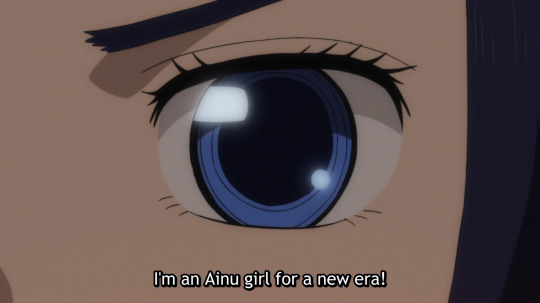

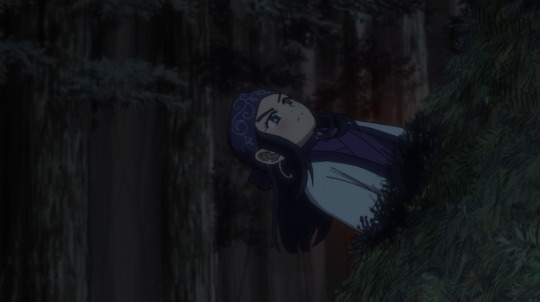
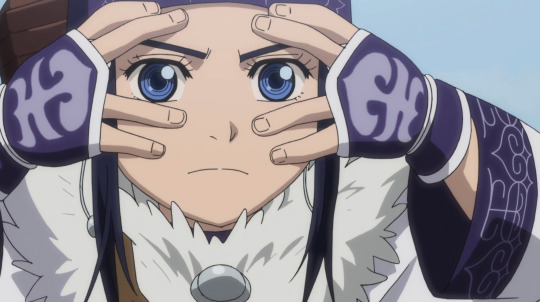
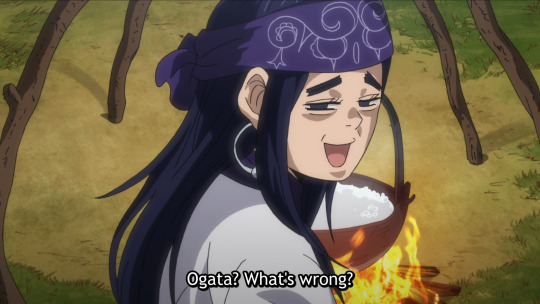
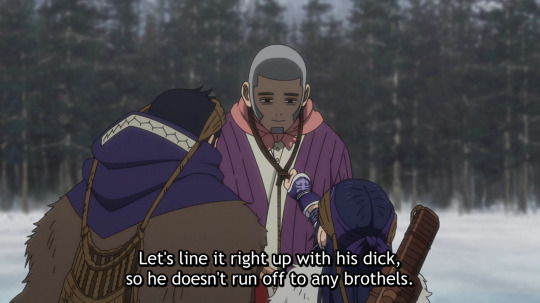
Asirpa my beloved
113 notes
·
View notes
Text

INUYASHA ALTERNATE UNIVERSE
Featuring a cast of the opposite gender and the different backstories and new characterizations that ensue...
Higurashi Kaoru (日暮 かおる) - AU Kagome. A cheerful, popular Tokyo high schooler. He is the reincarnation of a powerful Sengoku-era priest. This, in addition to Kaoru’s status as a scion of an old shrine family, has endowed him with a deep reserve of latent spiritual power. Kaoru is also of partial Ainu descent through his mother, enabling him to harness spiritual abilities different from those wielded by Shinto priests. This mix of spiritual energy within his person renders his potential unknown. He begins to learn to balance and control his powers when he falls down the old well at the Higurashi shine and frees Enju from her seal. He feels a deep spiritual resonance with her, but he can't place where exactly it comes from.
Enju (えんじゅ) - AU Inuyasha. A young half-demon girl with a mysterious past. After her mother's death, she fled to Hokkaidō to escape her late father's enemies. She claims to have lived there in peaceful solitude for several years, but her refusal to discuss anything about her time there and her recurrent nightmares suggest otherwise. She returned to Honshu with plans to steal the Shikon no Tama, but was stopped by Keijiro, a Shinto priest who was the jewel's protector. He ultimately sealed her to the Sacred Tree of Ages with a holy arrow. Though their relationship appeared purely adversarial, rumors swirling around the village for years after their deaths suggest that there was something more to the story. After many years, Kaoru breaks the seal and returns her to life. Shee feels a deep spiritual connection to him that terrifies her, though she isn't sure why or where it comes from. She is known as Enju, but it isn't her true name.
Tara (多羅) - AU Miroku. A young woman born to a family plagued by a strange demon's curse. Depressed and resentful of her family's expectation for her to either seek out the demon and destroy it or birth children to continue the family line, she runs away from her Buddhist training to become a traveling exorcist and healer. She knows she will not live to grow old, so even though she genuinely seeks to help those she meets in her travels, she lives recklessly, indulgently, and flirtatiously, not hesitating to resort to trickery to extract what she wants from wealthy men. Named for a female boddhisattva representing the "virtues of success in work and achievements."
Seidou (青銅) - AU Sango. A calm, collected, and quiet young man born in the Demon Slayer village. Renowned for his skill in battle, he catches the notice of a mysterious demon. The demon slaughters Seidou's entire family to corrupt him with hatred and possess him for use as an enforcer. However, the demon underestimates the strength of Seidou's soul, and Seidou is able to sequester the evil influence within him. However, he often feels the demon voice's compelling him to give in to his baser instincts. This begins to trouble him greatly as time goes on; in his continued despair and anger over his family's death, he begins to worry about where the demon's thoughts end and his own begin. Named after bronze, in accordance with Demon Slayer village tradition.
#inuyasha#inuyasha au#kagome#sango#miroku#my art#extracting every last drop of serotonin from this show
17 notes
·
View notes
Photo

an ainu girl for a new era
1K notes
·
View notes
Text
How are the characters called? (Vol 1 to 6)
(UPDATED! This new version covers till Vol 6 of the manga. New characters were added (Chiyoko, Ejiri Matasuke, Hidoro no Okami, Hidoro Shinpei, Hidoro Tamotsu, Ienaga Kano, Kamezō, Kantarō, Kiroranke, Komiya, Kusuda Umakichi, Mishima, Nishin Daijin, Yamamoto, Yodogawa Terunaka) and previous characters were expanded. Please, enjoy this new version as well!).
So, since I’m making a re-reading I thought to take advantage of it to check how the characters call themselves and each other as this goes often lost in the translations but can turn relevant later on.
By the way, in order to do this:.
- characters will be listed by their own name (regardless of it being used in the volume).
- in case of characters whose name is still unknown, I’ll use the Japanese labelling given to them for the Golden Kamuy contest.
- if a character appears in the volume but has no speaking role I’ll only list his name and update it with new info when I’ll do the following volumes (yes, even if I know the new info already… I’m trying to keep this ordered).
- the way characters addressed to themselves will be listed and so will the various form of ‘you’ they use to talk with other people.
- for soldiers their ranking, if known, will be listed.
- in case of nicknames they’ll be listed as well.
- next to each way of calling themselves/the others will be listed the number of the chapter when this happened for the first time.
- at the bottom you can find some useful explanation on the various way to say ‘I’, ‘you’ and the suffixes character use.
So let’s go on and see how the characters called each other in Vol 1-6 (which covers chap 1-59).
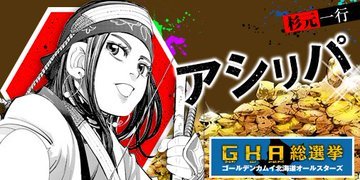
Asirpa (アシㇼパ)/Kochōbe Asuko (小蝶辺 明日子) - Previous name: Ekasiotonpuy (エカシオトンプイ).
Asirpa: She uses ‘Watashi’ (わたし/私 “I”) to talk about herself (Chap 2). She defines herself an ‘Atarashī jidai no Ainu no onna’ (新しい時代のアイヌの女 “Ainu woman for a new era”) (Chap 12). After being reunited to Sugimoto after he’d been captured she comments he had treated her like a ‘Kodomo’ (子供 “Child”) and had refused to trust her as his ‘Aibō’ (相棒 “Partner”) (Chap 20).
Asirpa & others: She uses ‘Watashi-tachi’ (わたしたち “We”) to talk about herself and Shiraishi and Sugimoto (Chap 28).
Gotō: Well, they don’t really get to talk so she refers to him simply as ‘Sono otoko’ (その男 “This man”) (Chap 1).
Henmi Kazuo: She calls him ‘Shūjin’ (囚人 “Prisoner”) (Chap 38).
Huci: She calls her ‘Huci’ (フチ Ainu word for “Grandmother”, which the Japanese translation translates as Obāchan’, おばあちゃん) (Chap 11).
Kiroranke: She calls him ‘Kiroranke Nispa’ (キロランケニㇱパ Ainu word for “Mister Kiroranke”) (Chap 47) and defines him as ‘Chichi no mukashi no yūjin’ (父の昔の友人 “Her father’s old friend”) (Chap 47).
Makanakkuru: She calls him ‘Acapo’ (アチャポ Ainu word for “Uncle” , which the Japanese translation translates as ‘Ojisan’ 叔父さん) (Chap 38).
Nihei Tetsuzō: When talking about him, Asirpa calls him ‘Nihei Tetsuzō’, saying she heard his name before (Chap 26). Saying they’ll catch him so they’ll protect Retar she calls him ‘Shūjin’ (囚人 “Prisoner”) (Chap 26). Watching Nihei aiming at something, she calls him ‘Ano Otoko’ (あの男 “That man”) (Chap 27) and when she can’t believe how tenacious he is, she calls him ‘Sono Otoko’ (その男 “This man”) (Chap 28).
Osoma: She calls her ‘Osoma’ (Chap 12).
Retar: She calls him ‘Retar’ (Chap 2). She also calls him ‘Horkew Kamuy’ (ホㇿケウカムイ Ainu word for “Wolf god”) (Chap 11) or ‘Omae’ (おまえ “You”) (Chap 14).
Ryū: When saying she won’t let him behind, she calls him ‘Ainu Inu’ (アイヌ犬 “Ainu dog”) (Chap 29). When he’ll show up while they’re hunting she calls him ‘Ryū’ and when he smells the scent of a bear and would like to follow it she calls him ‘Īko’ (いい子 “Good boy”) (Chap 36).
Shiraishi Yoshitake: In the beginning she keeps mispronouncing his nickname, calling him ‘Dappun-ō’ (脱糞王 “Defecation king”) (Chap 17) though she also uses ‘Omae’ (おまえ “You”) to call him (chap 15). When he tries to escape from her and fail though, she uses his true nickname ‘Datsugoku-ō’ (脱獄王 “Escape king”) (Chap 17). When claiming she has not much worth to him she calls him ‘Ano Otoko’ (あの男 “That man”) (Chap 28). She finally calls him ‘Shiraishi’ when he tosses the rifle on the ground (Chap 28). Telling him he has to stay because he’ll be of use to her she calls him ‘Omae’ (お前 “You”) (Chap 32). Finding him drunk and asleep she calls him ‘Yakudatazu no Shiraishi’ (役立たずの白石 “Useless Shiraishi”) (Chap 34) and ‘Kitanai otoko’ (汚い男 “Filthy man”) (Chap 34). After he gives Asirpa info about Henmi she claims she believed he was ‘Nonda kure teru tada no buta’(飲んだくれてるただのブタ “A drunken pig”) but now she had revalued him (Chap 38). When Shiraishi will say he’ll help them to meet Nopperabō she switches from calling him ‘Dappun-ō’ (脱糞王 “Defecation king”) to ‘Datsugoku-ō’ (脱獄王 “Escape king”) (Chap 49).
Sugimoto Saichi: In the beginning she uses just ‘Omae’ (お前 “You”) to call him (chap 1) and she’ll also refers to him as ‘Sisam’ (シサㇺ Ainu word for “not-Ainu Japanese person”) (Chap 2). Then she’ll starts to call him ‘Sugimoto’ also (Chap 2), though occasionally she’ll still call him a ‘Sisam’. She’ll call him ‘Fujimi no Sugimoto’ (不死身の杉元 “Sugimoto the Immortal”) when she’ll ask him what that nick means (Chap 5) though. She calls him ‘Baka’ (バカ”Stupid”) when he forgets his knife and bayonet (Chap 13). When asked by Kirokante why she’s with him she answers he’s her ‘相棒’ (Aibō “Partner”) (Chap 48)
Tanigaki Genjirō: When thinking Tanigaki might be still searching her she calls him ‘Ano Heishi’ (あの兵士 “That soldier”). When she says she doesn’t know if he’ll survive she calls him ‘Sono Otoko’ (その男 “This man”) (Chap 28). Entrusting her grandmother to him she calls him ‘Tanigaki’ (Chap 50).
Ushiyama Tatsuma: The first time she sees him she calls him ‘Sinna kisar’ (シンナキザㇻ Ainu word for “Strange ears”) (Chap 52). After he tells her which sort of man she has to pick she calls him ‘Sensei’ (先生 “Teacher”) (Chap 52). Escaping from the hotel she calls him ‘Chinpo Sensei’ (チンポ先生 “Professor penis”) (Chap 54).
Wilk: She calls him ‘Aca’ (アチャ Ainu word for “Father” , which the Japanese translation translates as ‘Otōsan’ お父さん) (Chap 14). When she can’t believe he’s the person in jail she refers to the person in jail as ‘Nopperabō’ (のっぺらぼ “Faceless male”) (Chap 48). When she wonders if he could be her father she calls him ‘Watashi no chichioya’ (私の父親 “My father”) (Chap 49).
Others: Talking about how she had to roast meat for Shiraishi and Sugimoto she calls them ‘Omae-ra mitaina tokai no moyashi-kko’ (お前らみたいな都会のもやしっ子 “You, little city boys”) (Chap 25).
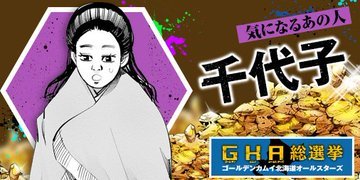
Chiyoko (千代子) .
Hidoro Shinpei: She calls him ‘Shinpei-chan’ (新平ちゃん “Dear Shinpei”) (Chap 59).
Nagakura Shinpachi: She calls him ‘Ojīchan’ (お爺ちゃん “Old man”) (Chap 57).
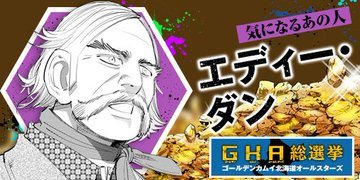
Dunn, Eddie (エディダン “Eddie Dunn”).
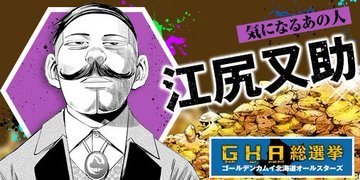
Ejiri Matasuke (江尻 又助).
Ejiri Matasuke: He uses ‘Ore’ (俺 “I”) to talk about himself (Chap 56).
Ogata Hyakunosuke: He calls him ‘Chinpira’ (チンピラ “Thug”) (Chap 56) (Chap 56).
Others: He calls Hijikata and Nagakura ‘Osamurai-san’ (お侍さん “Mister Samurai”) (Chap 56) (Chap 56)
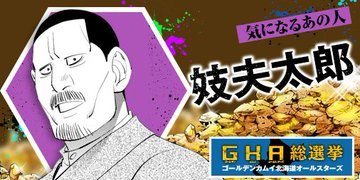
Gifutarō (妓夫太郎 “Pimp”).
Gifutarō: He uses ‘Ore’ (俺 “I”) to talk about himself (Chap 15).
Asirpa: He calls her ‘Ainu no gaki’ (アイヌのガキ “Ainu brat”) first, ‘Ainu no onna’ (アイヌの女 “Ainu woman”) short after and, when Asirpa hits him, ‘Kono kuso gaki’ (このクソガキ “this goddamn brat”) (Chap 3).
Shiraishi Yoshitake: Seeing him he calls him ‘Danna’ (ダンナ “Mister”) (Chap 33).
Sugimoto-tachi o Bikō Shite Ita Shūjin: He calls him ‘Otoko’ (男 “Man”) (Chap 3).
Sugimoto Saichi: He calls him ‘Omae’ (お前 “You”) (Chap 3) but later he switches to ‘Anta’ (あんた “You”) (Chap 15).
Ushiyama Tatsuma: Learning he’s the one who hurt a prostitute he calls him ‘Ano yarō’ (あの野郎 “That guy”) (Chap 33).
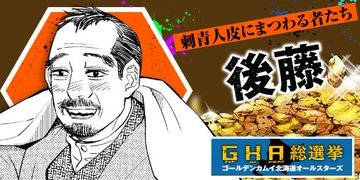
Gotō (後藤).
Gotō: He uses ‘Ore’ (俺 “I”) to talk about himself (Chap 1).
Sugimoto Saichi: He calls him first with his full name ‘Sugimoto Saichi-san’ (杉元佐一さん) then just ‘Sugimoto-san’ (杉元さん) or ‘Anta’ (あんた “You”). He also mentions how people during war used to call him ‘Fujimi no Sugimoto’ (不死身の杉元 “Sugimoto the Immortal”) but doesn’t use this nick (Chap 1).
Wilk: He calls him just ‘Otoko’ (男 “Man”) (Chap 1).
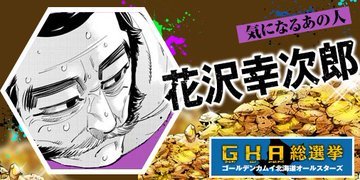
Hanazawa Kōjirō (花沢幸 次郎) - Rank: ‘Chūjō’ (中将 “Lieutenant General”).

Henmi Kazuo (辺見和雄).
Henmi Kazuo: He uses ‘Boku’ (僕 “I”) to talk about himself (Chap 38) but claims he gives off the scent of a a ‘Hitogoroshi’ (人殺し “Murderer”) (Chap 39).
Asirpa: He calls her ‘Ainu no musume-san’ (アイヌの娘さん “Miss Ainu girl”) (Chap 39).
Henmi Kazuo no Ototo: He calls him ‘Ototo’ (弟 “Younger brother”) (Chap 39).
Nishin Daijin: He calls him ‘Oyakata’ (親方 “Master”) (Chap 39).
Shiraishi Yoshitake: He will refer to him as ‘Shiraishi Yoshitake-san’ (白石由竹さん) (Chap 39).
Sugimoto Saichi: At first he will refer to him as ‘Kono Heitai’ (この兵隊 “This soldier”) and as Shiraishi’s ‘Nakama’ (仲間 “Comrade”) (Chap 39). After Sugimoto gives him a cover he’ll say of him ‘Yasashina… kono hito’ (やさしな… このひと “So gentle… this guy”) (Chap 39). However he will comment Sugimoto gives of the same scent he has, the one of a ‘Hitogoroshi’ (人殺し “Murderer”) (Chap 39). He then in this thoughts will calls him ‘Ano hito’ (あのひと “That guy”) and ‘kono hito’ (この人 “this guy”) (Chap 39). When asking him which hammer he would like to use he starts to call him ‘Sugimoto-san’ (杉元さん) (Chap 40). When the soldiers will ask if that man was Sugimoto though, he’ll call him just ‘Sugimoto’ (Chap 40). When about to fight him he asked him if he was called ‘Fujimi no Sugimoto’ (不死身の杉元 “Sugimoto the Immortal”), then to refer to him used ‘Anata’ (あなた “You”) (Chap 41). When Sugimoto suggest they could gleam together he’ll call him ‘Suteki na hito’ (素敵なひと “Wondeful person”) (Chap 41).

Hidoro no Okami (日泥の女将 “Hidoro’s proprietress”).
Chiyoko: She calls her ‘Onna’ (女 “Woman”) (Chap 57). Later she’ll call her ‘Chiyoko’ (Chap 59).
Hidoro Shinpei: She calls him ‘Musuko’ (息子 “son”) (Chap 56) and defines him a ‘Funuke’ (腑抜け “Coward”) (Chap 56). Talking to him she calls him ‘Shinpei’ (Chap 56) and ‘Anta’ (あんた “You”) (Chap 59).
Hidoro Tamotsu: She calls him ‘Anta’ (あんた “You”) (Chap 59).
Kusuda Umakichi: She calls him ‘Umakichi’ (Chap 57).
Nagakura Sinpachi: She calls him ‘Anta’ (あんた “You”) (Chap 57).
Yamamoto: She calls him ‘Yamamoto-san’ (山本さん “Mister Yamamoto”) and asks him since when he became ‘Umakichi no Kobun’ (馬吉の子分 “Umakichi’s underling”) (Chap 57).
Others: She calls Hijikata and Nagakura ‘Osamurai-san-gata’ (お侍さん方 “Mister Samurai (Plural)”) (Chap 56) and then ‘Otsure’ (お連れ “Companions/guests”) (Chap 56). She calls Hidoro Shinpei and Hidoro Tamotsu ‘Anta-ra’ (あんたら “You (Plural)”) (Chap 57)

Hidoro Shinpei (日泥 新平).
Hidoro Shinpei: He uses ‘Ore’ (俺 “I”) to talk about himself (Chap 56) but defines himself a ‘Okubyōmono’ (臆病者 “Coward”) (Chap 57).
Chiyoko: Talking about her with Hijikata and Nagakura he calls her ‘Mekake’ (妾 “Mistress”) (Chap 56) but with her he uses ‘Chiyoko’ (Chap 56).
Ejiri Matasuke: He calls him ‘Ejiri shochō’ (���尻署長 “Chief Ejiri”) (Chap 57).
Hidoro no Okami: He calls her ‘Okkā’ (おっ母 “Mother”) (Chap 56).
Hidoro Tamotsu: He calls him ‘Oyaji’ (オヤジ/親父 “Dad”) (Chap 55). When they argue he calls him ‘Anta’ (あんた “You”) (Chap 59)
Kusuda Umakichi: He calls him ‘Umakichi’ (Chap 57) and says he was Hidoro’s ‘Oyaji no migiude’ (オヤジの右腕 “My father’s right hand man”) (Chap 57).
Yamamoto: He calls him ‘Yamamoto’ (Chap 59).
Others: He calls Hijikata and Nagakura ‘Boke rōjin’ (ボケ老人 “Stupid old men”) (Chap 55), ‘Jijī’ (ジジイ“Old men”) (Chap 55) and ‘Toshiyori’ (年寄り “Old people”) (Chap 55). When he asks for their help he calls them ‘Osamurai-san’ (お侍さん “Mister Samurai”) (Chap 56).

Hidoro Tamotsu (日泥 保).
Chiyoko: He calls her ‘Chiyoko’ (Chap 57).
Hidoro Shinpei: He calls him ‘Kono yarō’ (この野郎 “Bastard”) (Chap 59), ‘Temē’ (テメエ “You”) (Chap 59).
Others: He calls Hijikata and Nagakura ‘Anta-ra’ (あんたら “You (plural)”) (Chap 55).
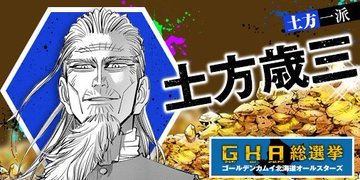
Hijikata Toshizō (土方 歳三) - Nicknamed ‘Oni no Fukuchō’ (鬼の副長 “Demonic vice-commander”), ‘Bakumatsu no Baragaki’ (幕末のバラ餓鬼 “Lingering ghoul of the Bakumatsu”), ‘Baragaki’ (バラガキ “Brat with a thorny personality”) and called ‘Danna’ (旦那 “Boss”) by his underlings.
Hijikata Toshizō: He uses ‘Watashi’ (私 “I”) to talk about himself (Chap 21). He also refers to himself as an ‘Ikinokori’ (生き残り “Survivor”) (Chap 55).
Asirpa: He defines her a ‘Menkoi ko’ (めんこい子 “Handsome little lady”) (Chap 43). He then calls her ‘Asirpa-chan’ (アシリパちゃん) (Chap 44). Asking about her to Kirokanke he calls her ‘Kochōbe Asuko’ (Chap 48).
Kusuda Umakichi: He calls him ‘Umakichi’ (Chap 56).
Hidoro no Okami: He calls her Shinpei’s ‘Okkā’ (おっ母 “Mother”) (Chap 56). When she doesn’t hand the skin he comments she is ‘ Hito no jō o mochiawasete inai’ (人の情を持ち合わせていない “A person who doesn’t posses human feelings”) (Chap 59).
Hidoro Shinpei: He calls him ‘Omae’ (お前 “You”) (Chap 55).
Hidoro Tamotsu: He calls him ‘Hidoro’ (Chap 55).
Nagakura Shinpachi: He calls him ‘Nagakura’ (Chap 20). He also refers to him as an ‘Ikinokori’ (生き残り “Survivor”) (Chap 55).
Ogata Hyakunosuke: He calls him ‘Ano otoko’ (あの男 “That man”) (Chap 56). He defines him as ‘ Yagura ni iru yatsu ichiban yakkai’ (やぐらにいる奴一番厄介 “The man on the watchtower is the main problem”) (Chap 58)
Shibukawa Zenjirō: Talking about him to Ushiyama he calls him ‘Shibukawa Zenjirō’ and says he is the ‘Tōzoku-dan no tōshu’ (盗賊団の頭首 “Leader of a band of thieves”) but then he switches on calling him just ‘Shibukawa’ when he tells Ushiyama he shouldn’t kill him (Chap 21). Meeting him though he’ll always call him ‘Shibukawa Zenjirō’ (Chap 21).
Shiraishi Yoshitake: Meeting him he calls him ‘Shiraishi’ (Chap 37).
Sugimoto Saichi: When speculating Shiraishi might have someone helping him he’ll call him ‘Nakama’ (仲間 “Comrade”) (Chap 37). Hearing his name and nickname he’ll repeat ‘Fujimi no Sugimoto’ (不死身の杉元 “Sugimoto the Immortal”) and will ask Shiraishi if he’s his ‘Aibō’ (相棒 “Partner”) (Chap 39). He then will start to refer to him as ‘Sugimoto’. (Chap 39)
Tsurumi Tokushirō: Seeing him for the first time he calls him ‘Tsurumi toka iu gunjin’ (鶴見とかいう軍人 “Tsurumi the soldier”) (Chap 34).
Ushiyama Tatsuma: When he first sees him he calls him ‘Fuhai no Ushiyama’ (不敗の牛山 “Ushiyama the Undefeated”), although he immediately switches to just ‘Ushiyama’ (Chap 12).
Wilk: Talking with Nagakura about him, he calls him ‘Aitsu’ (あいつ “That guy”) (Chap 30). Later he refers to him as ‘Nopperabō’ (のっぺらぼ “Faceless male”) (Chap 48).
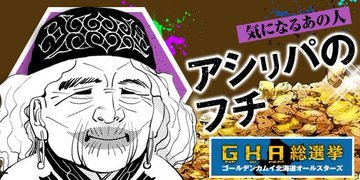
Huci (フチ Ainu word for “Grandmother”)
Asirpa: She calls her ‘Asirpa’ (アシㇼパ) (Chap 11).
Sugimoto Saichi: She calls him ‘Sugimoto Nispa’ (スギモトニㇱパ Ainu word for “Mister Sugimoto”) (Chap 12).
Tanigaki Genjirō: She calls him ‘Tanigaki Nispa’ (タニガキニㇱパ Ainu word for “Mister Tanigaki”) (Chap 44).
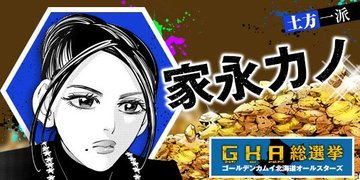
Ienaga Kano (家永 カノ)/Chikanobu (親宣) .
Ienaga Kano: She uses ‘Watashi’ (わたし/私 “I”) to talk about herself (Chap 50) and she introduces herself as the ‘Okami no Ienaga’ (女将の家永 “Ienaga, the proprietress”).
Shiraishi Yoshitake: Talking about him she calls him ‘Shiraishi’ (Chap 51). When he tosses against her the second explosive she calls him ‘Tako bōzu’ (タコ坊主 “Bald head”) (Chap 54).
Sugimoto Saichi: While telling him about Ushiyama she calls him ‘Okyakusama’ (お客様 “Customer”) (Chap 53).
Ushiyama Tatsuma: Meeting him she calls him ‘Okyakusama’ (お客様 “Customer”) (Chap 50) although, when she thinks at him, she calls him ‘Ushiyama’ (Chap 51). As she’s escaping she calls him ‘ Zenshin chinpo yarō’ (全身チンポ野郎 “Walking dick bastard”) (Chap 53). Telling Sugimoto he’s a convict she calls him ‘Fuhai no Ushiyama’ (不敗の牛山 “Ushiyama the Undefeated”) (Chap 53). When she asks him when he was perfect she calls him ‘Anata’ (あなた “You”) (Chap 54).
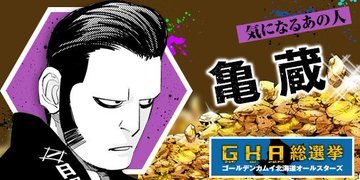
Kamezō (亀蔵).
Hijikata Toshizō: He calls him a ‘Jīsan’ (爺さん “Old man”) (Chap 58).
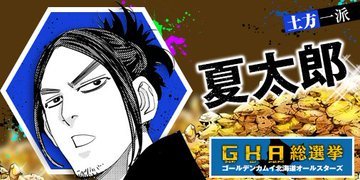
Kantarō (夏太郎).
Ogata Hyakunosuke: He calls him ‘ Yagura no otoko’ (やぐらの男 “The watchtower man”) (Chap 58).
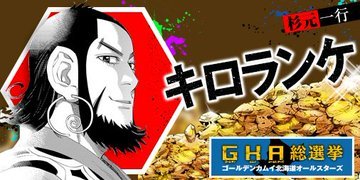
Kiroranke (キロランケ)/ Yulbars (Юлбарс/ユルバルス).
Kiroranke: He uses ‘Ore’ (俺 “I”) to talk about himself (Chap 48) and refers to himself as ‘Ore wa dainana shidan’ (俺は第七師団 “Member of the 7th division”) (Chap 23), claiming he is a ‘E-hei’ (エ兵 “Combat engineer”)
Kiroranke & others: He uses ‘Ore-tachi’ (俺たち “We”) to talk about himself and Wilk (Chap 49).
Asirpa: He calls her ‘Asirpa’ (アシㇼパ) (Chap 47) and ‘Omae’ (お前 “You”) (Chap 48).
Hijikata Toshizō: He calls him a ‘Toshioita wajin’ (年老いた和人 “Old Japanese man”) (Chap 48).
Shiraishi Yoshitake: When hearing it he’ll repeat Shiraishi’s nickname ‘Datsugoku-ō’ (脱獄王 “Escape king”), asking what it means (Chap 49). He then starts to call him ‘Shiraishi’ (シライシ) (Chap 51). Complaining he blew up all his explosive he calls him ‘Shiraishi no yarō’ (シライシの野郎 “Damn Shiraishi”) (Chap 55).
Sugimoto Saichi: When hearing his name he calls him ‘Sugimoto’ and then ‘Fujimi no Sugimoto’ (不死身の杉元 “Sugimoto the Immortal”) (Chap 48). He then defines him ‘Sensō no eiyū’ (戦争の英雄 “War hero”) (Chap 48). When saying no bodies were found he calls him ‘Sugimoto’ (Chap 55).
Tanigaki Genjirō: When he sees him he calls him first ‘Omae’ (おまえ “You”) then ‘Asirpa no Oji’ (アシㇼパの叔父 “Asirpa’s younger uncle”).
Tsurumi Tokushiro: Hearing about him he calls him ‘Tsurumi chūi’ (鶴見中尉 “First Lieutenant Tsurumi”) (Chap 48).
Ushiyama Tatsuma: The first time he sees him he calls him ‘Sinna kisar’ (シンナキザㇻ Ainu word for “Strange ears”) (Chap 52). After he tells Asirpa which sort of man she has to pick he calls him ‘Sensei’ (先生 “Teacher”) (Chap 52).
Wilk: Talking about him he calls him ‘Nopperabō’ (のっぺら坊 “Faceless male”) (Chap 48) and says he’s ‘Asirpa no chichioya’ (アシㇼパの父親 “Asirpa’s father”) (Chap 48). Looking at Shiraishi’s tattoo he claims the only person who could do it is ‘Ano hito’ (あの人 “That person”) (Chap 49).
Others: Talking about how he is okay with Shiraishi and Sugimoto getting their share of gold he calls them ‘Omae-tachi’ (お前たち “You (Plural)”) (Chap 49).

Komiya (小宮) - Rank: ‘Ittōhei’ (一等兵 “Private First Class”)

Kusuda Umakichi (久寿田 馬吉).
Kusuda Umakichi: He uses ‘Ore’ (俺 “I”) to talk about himself (Chap 58).
Chiyoko: He calls her Hidoro’s ‘Miomo no mekake’ (身重の妾 “Pregnant mistress”) (Chap 55) or ‘Hidoro no mekake’ (日泥の妾 “Hidoro’s mistress”) (Chap 55).
Ejiri Matasuke: He calls him ‘Ejiri shochō’ (江尻署長 “Chief Ejiri”) (Chap 58).
Hidoro Tamotsu: He calls him ‘Hidoro’ (Chap 55) and ‘Nishin-ba no Hidoro’ (ニシン場の日泥 “Hidoro of the herring fishery”) (Chap 55).
Ogata Hyakunosuke: He calls him ‘Sensei’ (先生 “Master”) (Chap 56).
Others: He calls Hijikata and Nagakura ‘Danna-gata’ (旦那方 “Sirs”) (Chap 55).
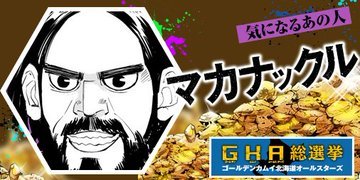
Makanakkuru (マカナックル).
Makanakkuru: He uses ‘Watashi’ (私”I”) to talk about himself (Chap 13).
Asirpa: He calls her ‘Asirpa’ (アシㇼパ) (Chap 13) and says she is ‘Watashi no ane no musume’ (私の姉の娘 “His elder sister’s daughter”) (Chap 13).
Henmi Kazuo: He calls him a ‘Ryōshi’ (漁師 “Fisherman”) (Chap 38).
Soldiers of the 7th: Talking with Tanigaki he calls them ‘Omae-tachi’ (おまえたち “You” (plural)) (Chap 30).
Retar: He calls him ‘Retar’ (Chap 14) and defines him a ‘Horkew Kamuy’ (ホㇿケウカムイ Ainu word for “Wolf god”) (Chap 14).
Shiraishi Yoshitake: He calls him ‘Shiraishi’ when he says he’ll head after him (Chap 39).
Sugimoto Saichi: He calls him ‘Sugimoto-san’ (杉元さん) (Chap 14). Later he switches to just ‘Sugimoto’ when calling him (Chap 38).
Wilk: He calls him ‘Asirpa no tō’ (アシㇼパの父 “Asirpa’s father”) (Chap 13).
Others: Talking to Asirpa’s group he calls them ‘Omae-tachi’ (お前たち “You” (plural)) (Chap 38).
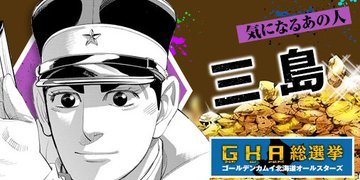
Mishima (三島) - Rank: ‘Ittōhei’ (一等兵 “Private First Class”)
Nikaidō Kōhei: He calls him ‘Nikaidō’ (Chap 46).
Ogata Hyakunosuke: He calls him ‘Ogata Jōtōhei’ (尾形 百之助上等兵 “Superior Private Ogata”) (Chap 46).
Tamai: Talking about him he calls him ‘Tamai Gochō’ (玉井伍長 “Corporal Tamai”) (Chap 46)
Tanigaki Genjirō: He calls him ‘Tanigaki’ (Chap 46) and ‘Omae’ (お前 “You”) (Chap 46).
Tsurumi Tokushirō: He calls him ‘Tsurumi Chūi’ (鶴見中尉 “First Lieutenant Tsurumi”) (Chap 46) and then just ‘Chūi’ (中尉 “First Lieutenant”) (Chap 46).
Others: He calls Tamai’s group ‘Tamai Gochō-tachi’ (玉井伍長たち “Corporal Tamai and co”) (Chap 46)
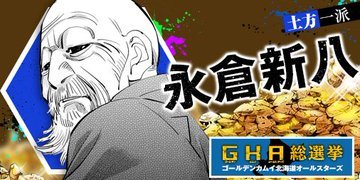
Nagakura Shinpachi (永倉 新八) – Nicknamed ‘Gamushin’ (ガムシン “Reckless Shin(pachi)”).
Nagakura Shinpachi: He uses ‘Watashi’ (私 “I”) to talk about himself (Chap 20). When he’s about to face Kusuda Umakichi’s men he refers to himself as ‘Kono Nagakura Shinpachi’ (この永倉 新八 “This Nagakura Shinpachi”) (Chap 58).
Nagakura Shinpachi & others: He uses ‘Watashi-tachi’ (私たち “We”) to talk about himself and Hijikata’s group (Chap 39).
Chiyoko: He calls her Hidoro’s ‘Mekake (妾 “Mistress”) (Chap 56).
Ejiri Matasuke: He says he is ‘Keisatsu no bun shochō’ (警察の分署長 “Local police chief”) (Chap 56).
Hidoro no Okami: He defines her ‘Hidoro-ka no hontō no oyabun’ (日泥家の本当の親分 “Hidoro family’s real boss”) (chap 56) and, talking with Shinpei he calls her his ‘Okkā’ (おっ母 “Mother”) (Chap 56). Seeing she hid the tattooed skin she calls her ‘Ano Okami’ (あの女将 “That proprietress”) (Chap 59)
Hidoro Shinpei: He calls him ‘Omae’ (お前 “You”) (Chap 56).
Hidoro Tamotsu: He calls him ‘Hidoro’ (Chap 55).
Hijikata Toshizō: He calls him ‘Hijikata-san’ (土方さん) (Chap 20) and ‘Anata’ (あなた “You”) (Chap 21).
Kusuda Umakichi: He calls him ‘Umakichi’ (Chap 56).
Sugimoto Saichi: When talking about him with Shiraishi he’ll define him Shiraishi’s ‘Yōjinbō’ (用心棒 “Bodyguard”) (Chap 39).
Ushiyama Tatsuma: Hearing him screaming he wants a woman he calls him ‘Kedamono’ (ケダモノ “Beast”) (Chap 33). Later, when Ushiyama will call him and Hijikata old guys he’ll call him ‘Kozō’ (小僧 “Youngster/Errand boy”) (Chap 33).
Others: He calls Kusuda Umakichi and his men ‘Kisama-ra’ (貴様ら “You (Plural)”) (Chap 58).
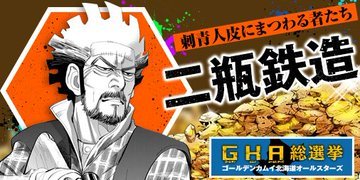
Nihei Tetsuzō (二瓶 鉄造) - Nicknamed ‘Kumauchi’ (熊撃ち “Bear shooter”) and ‘Tōmin-chū no higuma mo unasareru akumu no kumauchi’ (冬眠中の羆も魘される悪夢の熊撃ち “The hunter who gives hibernating bears nightmares”).
Nihei Tetsuzō: He uses ‘Ore’ (オレ and 俺 “I”) to talk about himself (Chap 22 & 26). When he talks about his cuisine he uses ‘Nihei’ (ニヘイ) (Chap 23). When he has to fight Retar he defines himself a ‘Kemono’ (獣 “Beast”) (Chap 29) and ‘Ore ippiki’ (俺一匹 “This one animal”) (Chap 29).
Asirpa: Asking Tanigaki if he’s talking about her he calls her ‘Ainu no Shōjo’ (アイヌの少女 “Ainu girl”) (Chap 25). Saying Tanigaki to take her away he calls her ‘Sono ko’ (その子 “This child”) (Chap 28). While talking with her he calls her ‘Ojō-chan’ (お嬢ちゃん “Miss”) (Chap 28)
Dunn, Eddie: Talking about who caused the wolves extinction he calls him an ‘America-jin’ (アメリカ人 “American”) (Chap 24).
Matagi: He refers to them as ‘Matagi’ (Chap 22). Talking about the Matagi he calls them ‘Monooto tatezu ni kōdō suru seiei butai’ (物音立てずに行動する精鋭部隊 “Elite troops acting without sound”) (Chap 23) and ‘Omae-ra’ (お前ら “You (Plural)”) (Chap 23).
Retar: He first calls him ‘Saishū no ōkami’ (最終の狼 “Last wolf”) (Chap 23), then just ‘Ōkami’ (狼 “Wolf”) (Chap 24). When he has to fight Retar he defines him a ‘Kemono’ (獣 “Beast”) (Chap 29).
Ryū: He first calls him ‘Kono inukkoro’ (この犬っころ “This little dog”) (Chap 22), then just ‘Ryū’ (Chap 22). When explaining Ryū is trained not to feel fear when facing a bear he calls him ‘Ainu Inu’ (アイヌ犬 “Ainu dog”) (Chap 24). When they’re spending the night waiting for Retar to show up he calls him ‘Daken’ (駄犬 “Mongrel”) and ‘Yutanpo’ (湯たんぽ “Hot water bottle”) (Chap 26).
Shiraishi Yoshitake: Seeing him he calls him ‘Shiraishi’ (Chap 27). When he and Sugimoto escape he calls him by his nickname ‘Datsugoku-ō’ (脱獄王 “Escape king”) (Chap 28).
Tanigaki Genjirō: He first calls him just ‘Matagi’ (マタギ “Matagi”) (Chap 22) then ‘Matagi no heitai-san’ (マタギの兵隊さん “Mister Matagi Soldier”) (Chap 22). He then calls him ‘Matagi no Tanigaki’ (マタギの谷垣 “Matagi Tanigaki”) (Chap 22). He then calls him ‘Omae-san’ (お前さん “You”) (Chap 23). As they’re eating though he calls him just ‘Tanigaki’ (Chap 23). Later he claims he’s a ‘Monoshizukana yakko’ (物静かな奴 “Very quiet guy”) (Chap 23). After knowing why Tanigaki was there, Nihei switches to call him ‘Omae’ (お前 “You”) (Chap 23). When asking him if he had forgotten how to hunt after being in the war he calls him ‘Matagi no Tanigaki-chan’ (マタギの谷垣ちゃん “Little Matagi Tanigaki”) (Chap 24). When asking him if he’s a Matagi or a soldier he calls him ‘Matagi no Tanigaki ka Heitai-san no Tanigaki ka’ (マタギの谷垣か兵隊さんの谷垣か “Tanigaki the Matagi or mister Tanigaki the soldier?”) (Chap 26)

Nikaidō Kōhei (二階堂 浩平) - Rank: ‘Ittōhei’ (一等兵 “Private First Class”).
Nikaidō Kōhei: He uses ‘Ore’ (俺 “I”) to talk about himself (Chap 45) and asks Ogata if he’s supposed to become ‘Esa’ (エサ “Bait”) (Chap 45).
Komiya: He calls him ‘Komiya’ (Chap 46).
Huci: He calls her ‘Bāchan’ (バアチャン “Grandmother”) (Chap 42)
Nikaido Yōhei: He calls him ‘Yōhei’ (Chap 17).
Ogata Hyakunosuke: When attacked by the bear he calls him ‘Kuso Ogata’ (クソ尾形 “Damned Ogata”) (Chap 45) then just ‘Ogata’ (Chap 45)
Tamai: Talking about him he calls him ‘Tamai Gochō’ (玉井伍長 “Corporal Tamai”) (Chap 43)
Tanigaki Genjirō: Talking about him he calls him ‘Ano yarō’ (あの野郎 “That bastard”) (Chap 45) and then just ‘Tanigaki’ (Chap 45)
Tsurumi Tokushirō: When talking about him he calls him ‘Tsurumi chūi’ (鶴見中尉 “First Lieutenant Tsurumi”) (Chap 45). Talking with him he calls him ‘Tsurumi chūi-dono’ (鶴見中尉殿 “First Lieutenant Tsurumi, sir”) (Chap 46)
Sugimoto Saichi: He uses ‘Omae’ (お前 “You”) to call him (chap 15) and then after Tsurumi has interrogated him ‘Kushi dango yarō’ (串団子野郎 “Dango boy”) (Chap 17). After losing his ears he calls him ‘Sugimoto Saichi’ (Chap 46).
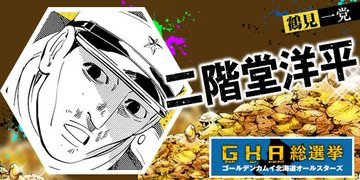
Nikaidō Yōhei (二階堂 洋平) - Rank: ‘Ittōhei’ (一等兵 “Private First Class”).
Nikaidō Yōhei: He uses ‘Ore’ (俺 “I”) to talk about himself (Chap 17).
Nikaidō Kōhei: He calls him ‘Kōhei’ (Chap 17).
Sugimoto Saichi: He calls him ‘Temē’ (てめえ “You”) when he asks him what he’s babbling about (Chap 17).
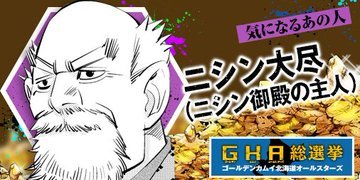
Nishin Daijin (Nishin goten to Shujin) (ニシン大尽 (ニシン御殿の主人) “Herring Great Magnate (Master of the herring palace)”).
Nishin Daijin: He uses ‘Ore’ (俺 “I”) to talk about himself (Chap 40).
Tsurumi Tokushirō: He calls him ‘Tsurumi-san’ (鶴見さん) (Chap 40).

Noma (野間) - Rank: ‘Ittōhei’ (一等兵 “Private First Class”).
Noma: He uses ‘Ore’ (俺 “I”) to talk about himself (Chap 10).
Sugimoto Saichi: Understanding who he is, first he calls him ‘Dai ichi shidan no Sugimoto’ (第一師団の杉元 “Sugimoto of the first division”) then ‘Fujimi no Sugimoto’ (不死身の杉元 “Sugimoto the Immortal”) (Chap 9). Ordering him to get down on his stomach he calls him ‘Sugimoto’ (Chap 10).
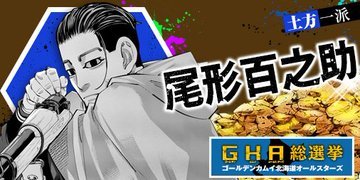
Ogata Hyakunosuke (尾形 百之助) - Rank: ‘Jōtōhei’ (上等兵 “Superior Private”) – Nicknamed ‘Kokō yamaneko’ (孤高山猫 “Solitary Wildcat”).
Ogata Hyakunosuke: He uses ‘Ore’ (俺 “I”) to talk about himself (Chap 43). Asking Hijikata if he can work for him he says he’s ‘Ude no tatsu yōjinbō’ (腕の立つ用心棒 “Skilled bodyguard”) (Chap 59).
Asirpa: Talking about her he calls her ‘Ainu no kodomo’ (アイヌの子供 “Ainu child”) (Chap 43).
Chiyoko: He calls her ‘Mekake no ie’ (妾の家 “Mistress of the house”) (Chap 57).
Ejiri Matasuke: He calls him ‘Shochō’ (署長 “Chief”) (Chap 56) and nicknames him ‘Ketsu ago’ (ケツ顎 “asscrack chin”) (Chap 56). He also calls him ‘Ketsu Shochō’ (ケツ署長 “Ass Chief”) (Chap 57).
Hidoro no Okami: He calls her ‘Hidoro Okami’ (日泥女将 “Hidoro’s proprietress”) (Chap 58).
Hidoro Shinpei: He calls him ‘Temē’ (テメエ “You”) (Chap 59) and says ‘Temē mitaina ikuji no nai yatsu ga ichiban mukatsuku nda’ (テメエみたいな意気地の無い奴が一番むかつくんだ “A guy without character like you is the most annoying”) (Chap 59).
Hijikata Toshizō: Discovering his cartridge he calls him ‘Ano jīsan’ (あの爺さん“That old man”)(Chap 57). Saying he has recognized him he calls him ‘ Hijikata Toshizō-san’ (土方歳三さん “Mister Hijikata Toshizō”)(Chap 59).
Kusuda Umakichi: He calls him ‘Umakichi’ (Chap 56).
Mishima: He calls him ‘Mishima’ (Chap 46).
Nagakura Shinpachi: He calls him ‘Jijī’ (ジジイ “Old man”) (Chap 57).
Noma: Talking about him he calls him ‘Noma’ (Chap 43).
Nikaidō Kōhei: He calls him ‘Nikaidō’ (Chap 43).
Ogata Hyakunosuke no soba (尾形 百之助の祖母 “Ogata Hyakunosuke’s grandmother”): Talking about her with Nikaidō he calls her ‘Bāchan’ (バアチャン “Grandmother”) (Chap 43)
Okada: Talking about him he calls him ‘Okada’ (Chap 43).
Sugimoto Saichi: In the beginning he uses ‘Kisama’ (きさま “You”) to call him, then, understanding who he is, first he calls him ‘Dai ichi shidan no Sugimoto’ (第一師団の杉元 “Sugimoto of the first division”) then ‘Fujimi no Sugimoto’ (不死身の杉元 “Sugimoto the Immortal”) (Chap 5).
Tamai: Talking about him he calls him ‘Tamai Gochō’ (玉井伍長 “Corporal Tamai”) (Chap 43).
Tanigaki Genjirō: When first meeting him he calls him Tanigaki Genjirō Ittōhei’ (谷垣 源次郎一等兵 “Private First Class Tanigaki Genjirō”) (Chap 42).When commenting it was Tanigaki the one the villagers spoke about he first called him ‘Tanigaki’ then ‘Omae’ (おまえ/お前 “You”) (Chap 43). He defines him a ‘Majimena otoko’ (真面目な男 “Earnest guy”) (Chap 43). He defines him as a ‘Matagi’ (マタギ “Matagi”) (Chap 45).
Tsurumi Tokushirō: Talking with Tanigaki he calls him ‘Tsurumi chūi’ (鶴見中尉 “First Lieutenant Tsurumi”) (Chap 43). Escaping from him he calls him ‘Tsurumi chūi-dono’ (鶴見中尉殿 “First Lieutenant Tsurumi, sir”) (Chap 46).
Other: Talking about Tamai’s group he calls them ‘Tamai Gochō-tachi’ (玉井伍長たち “Corporal Tamai and the others”) (Chap 43). He calls Hijikata and Nagakura ‘Anta-ra’ (あんたら “You (Plural)”) (Chap 59).

Okada (岡田) - Rank: ‘Ittōhei’ (一等兵 “Private First Class”).
Sugimoto Saichi: After Noma told him who he is, he calls him ‘Fujimi no Sugimoto’ (不死身の杉元 “Sugimoto the Immortal”) (Chap 9).

Osoma (オソマ).
Osoma: She uses ‘Atashi’ (あたし “I”) to talk about herself (Chap 12).
Asirpa: She calls her ‘Asirpa’ (アシㇼパ) (Chap 44).
Nikaidō Kōhei: She calls him ‘Sinna kisar’ (シンナキザㇻ Ainu word for “Strange ears”) (Chap 43).
Ogata Hyakunosuke: She calls him ‘Sinna kisar’ (シンナキザㇻ Ainu word for “Strange ears”) (Chap 43).
Ryū: She calls him ‘Ryū’ (Chap 44).
Shiraishi Yoshitake: She calls him ‘Sinna kisar’ (シンナキザㇻ Ainu word for “Strange ears”) (Chap 30).
Sugimoto Saichi: She first calls him ‘Sinna kisar’ (シンナキザㇻ Ainu word for “Strange ears”) then ‘Henna mimi’ (変な耳 “Strange ears”) (Chap 12).
Tanigaki Genjirō: She calls him ‘Sinna kisar’ (シンナキザㇻ Ainu word for “Strange ears”) (Chap 43). She calls him ‘Tanigaki Nispa’ (タニガキニㇱパ Ainu word for “Mister Tanigaki”) (Chap 44).

Retar (レタㇻ)
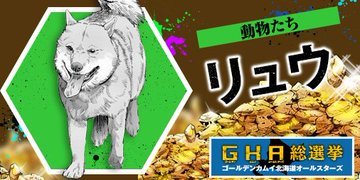
Ryū (リュウ)

Shibukawa Zenjirō (渋川 善次郎).
Shibukawa Zenjirō: He uses ‘Ore’ (俺 “I”) to talk about himself (Chap 21).
Hijikata Toshizō: He calls him ‘Anta’ (あんた “You”) (Chap 21).
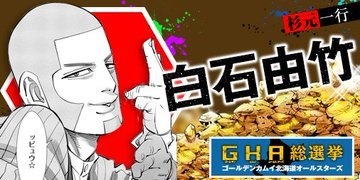
Shiraishi Yoshitake (白石 由竹) - Nicknamed ‘Datsugoku-ō’ (脱獄王 “Escape king”).
Shiraishi Yoshitake: He uses ‘Ore’ (俺 “I”) to talk about himself (Chap 6) although he also refers to himself by his nickname ‘Datsugoku-ō’ (脱獄王 “Escape king”) (Chap 7). Seeing Asirpa asleep he understands she wanted him to stay so he’ll be her ‘Yutanpo’ (湯たんぽ “Hot water bottle”) (Chap 32). He introduces himself to Ienaga as ‘Shiraishi Yoshitake’ (シライシ ヨシタケ) (Chap 51).
Shiraishi Yoshitake & others: He uses ‘Ore-tachi’ (俺たち “We”) to talk about himself Asirpa and Sugimoto (Chap 30).
Asirpa: He calls her ‘Sono Ainu’ (そのアイヌ “This Ainu”) when he asks Sugimoto if she’s his ‘Kaiinu’ (飼いイヌ “Pet dog/Pet Ainu”, through it’s actually a wordplay that takes advantage of how the last part of the word aINU is ‘Inu’, which written with this kanji 犬 means “dog”). Meeting her again he calls her ‘Ainu no Gaki’ (アイヌのガキ “Ainu brat”) (Chap 17) to switch to just ‘Omae’ (おまえ “You”) when he thinks Sugimoto double crossed her (Chap 17). Explaining to Sugimoto why he came to save him he calls her ‘Okkanai Ainu no musumekko’ (おっかないアイヌの娘っ子 “Scary Ainu girl”) (Chap 18). He calls her ‘Asirpa-chan’ (アシリパちゃん) (Chap 20). When saying they shouldn’t use her as hostage he calls her ‘Kodomo’ (子供 “Child”) (Chap 28).
Gifutarō: While escaping from Shiraishi he calls him ‘Dekabutsu’ (デカブツ “Big lump”) and then ‘Omae’ (お前 “You”) (Chap 33).
Gotō: Talking about him he calls him ‘Gotō no Ossan’ (後藤のおっさん “Old man Gotō”) (Chap 31).
Hijikata Toshizō: He defines him as ‘Shūjin-tachi no Oyadama’ (囚人たちの親玉 “leader of the prisoners”) (Chap 7) and explains they thought he was just a ‘Jī-san’ (ジイさん “Old man”), a ‘Seiji-han’ (政治犯 “Political prisoner”), ‘Mohan-shū’ (模範囚 “Model prisoner”) but then discovered he was a ‘Kyū bakufu-gun no samurai’ (旧幕府軍の侍 “Samurai of the former shogunate army”), the ‘Shinsenkumi Oni no Fukuchō Hijikata Toshizō’ (新撰組鬼の副長土方 歳三 “Demonic vice-commander of the Shinsengumi Hijikata Toshizō”) (Chap 7). Meeting him he calls him ‘Hijikata Toshizō’ (Chap 37). Meeting him in a worker lodge he calls him ‘Jijī’’ (このジジイ “This old man”) (Chap 43)
Henmi Kazuo: Talking about him with Sugimoto and Asirpa he calls him ‘Henmi’ (Chap 37). Recalling their past together he’ll call him ‘Henmi Kazuo’ (Chap 38). As the orca starts tossing him around he resumes calling him just ‘Henmi’ (Chap 41).
Huci: After hearing the legend of the gold from her he calls her ‘Bā-chan’ (ばちゃん “Grandmother”) (Chap 30).
Ienaga Kano: Asking her name he calls her ‘Ienaga-san’ (家永さん “Miss Ienaga”) (Chap 51) and claiming he’s falling for her he calls her ‘Ienaga Kano-san’ (家永カノさん “Miss Ienaga Kano”) (Chap 51). When trying to enter in the room he believes she was in, he calls Ienaga ‘Kano-san’ (カノさん “Miss Kano”) (Chap 51). When she injects something in him he calls her just ‘Ienaga’ (Chap 52). When thinking at her as Chicanobu he calls him a ‘Jijī’ (ジジイ “Old man”) (Chap 53). Escaping from her he calls her ‘Hentai isha’ (変態医者 “Perverted doctor”) (Chap 53).
Kiroranke: Asking Sugimoto if it’ll be safe to take him with them he calls him ‘Ano otoko’ (あの男 “That man”) (Chap 49). Telling him they’ve to leave the hotel he calls him ‘Kiroranke’ (Chap 53).
Nihei Tetsuzō: Talking about him he says he is a ‘Ude no tatsu ryōshi’ (腕の立つ猟師 “Ridiculously skilled hunter”) and is nicknamed by pelt trader as ‘Tōmin-chū no higuma mo unasareru akumu no kumauchi Nihei Tetsuzō’ (冬眠中の羆も魘される悪夢の熊撃ち二瓶鉄造 “The hunter who gives hibernating bears nightmares, Nihei Tetsuzō”) (Chap 25). Saying it’s him he calls him ‘Nihei Tetsuzō’ (Chap 27). Comparing him to Ushiyama he calls him ‘Nihei’ (Chap 31).
Retar: When he’s awakened by him he calls him ‘Yōkai’ (妖怪 “Ghost/Monster”) (Chap 17). He then calls him ‘Retar’ (Chap 34).
Ryū: When the two of them fight he calls him ‘Kono wan-bun’ (このワン分 “This small dog”). He calls him ‘Ryū’ (Chap 36). When Ryū escapes leaving him alone with Ushiyama he calls him ‘Kuso Inu’ (クソ犬 “Damned dog”) (Chap 37).
Sugimoto Saichi: At first he calls him ‘Omae-chan’ (お前ちゃん “You”) (chap 6) to switch to just ‘Omae’ (お前 “You”) when they risk dying of hypothermia (Chap 7). After they talk, when he says bye to him he calls him ‘Fujimi no Sugimoto’ (不死身の杉元 “Sugimoto the Immortal”) (Chap 7). Discovering Sugimoto is still alive despite having been captured by the 7th he calls him ‘Shibutoi yarō’ (しぶとい野朗 “Stubborn guy”) and ‘Sugimoto no yarō’ (杉元の野朗 “That Sugimoto guy”) (Chap 18). Afterward he’ll usually go for ‘Sugimoto’ (Chap 18) though he’ll slip back to ‘Fujimi no Sugimoto’ (不死身の杉元 “Sugimoto the Immortal”) when talking about him to Hijikata (Chap 37). When Hijitaka will question him further he’ll say Sugimoto is more his ‘Kobun’ (子分 “Henchman”) than an ‘Aibō’ (相棒 “Partner”) (Chap 39). After Sugimoto killed Henmi he comments ‘Koitsu ga ichiban okkane e’ (こいつが一番おっかねえ “This guy is the most dangerous of all”) (Chap 42)
Sugimoto-tachi o Bikō Shite Ita Shūjin: Seeing his skin he calls him a ‘Zako’ (雑魚 “Small fish”) (Chap 31).
Tanigaki Genjirō: He calls him ‘Tanigaki’ (Chap 36).
Tsurumi Tokushirō: Seeing him wear the tattooed skin he calls him ‘Hentai Chūi’ (変態中尉 “Perverted First Lieutenant”) (Chap 19). Talking about him with Tanigaki he also calls him ‘Tsurumitte yatsu’. (鶴見って奴 “That Tsurumi guy”) (Chap 31). Suggesting to report him he calls him ‘Tsurumi Chūi’ (鶴見中尉 “First Lieutenant Tsurumi”) (Chap 50).
Tsuyama: Talking about him he calls him ‘33-Ri koroshita Tsuyama’ (33人殺した津山 “Tsuyama who killed 33 people”) (Chap 31) then just ‘Tsuyama’ (Chap 31).
Ushiyama Tatsuma: Talking about him he calls him ‘Fuhai no Ushiyama’ (不敗の牛山 “Ushiyama the Undefeated”) (Chap 31). Escaping from him he calls him simply ‘Ushiyama’ (Chap 33). As he wonders how he can stops him he calls him ‘Ano abare ushi’ (あの暴れ牛 “That raging bull”) (Chap 33). Asking to the whores if they’ve seen him he called him ‘Irezumi no otoko’ (入れ墨の男 “Tattoed man”) (Chap 34). Asking him what he’s doing at the Sapporo hotel he calls him ‘Anta’ (アンタ “You”) (Chap 54). Hearing Asirpa calling him as such he also echoes her words and calls him ‘Chinpo Sensei’ (チンポ先生 “Professor penis”) (Chap 54).
Wilk: He calls him ‘Nopperabō’ (のっぺら坊 “Faceless male”) as he didn’t have a face (Chap 7).
Others: Talking about Asirpa and Sugimoto he calls them ‘Omae-ra’ (お前ら “You (Plural)”) (Chap 18). Later when he’ll see a tense atmosphere between Sugimoto and Asirpa he’ll always call them ‘Omae-ra’ (オマエら “You (Plural)”) but it’ll be written in a different way (Chap 20) and he’ll claim he won’t intrude in their ‘Fūfugenka’ (夫婦喧嘩 “Matrimonial quarrel”), basically comparing them to a ‘Fūfu’ (夫婦 “Married couple”) (Chap 20). Talking about Sugimoto and Kiroranke he calls them ‘Sensō kaeri’ (戦争帰り “War returners/veterans”) (Chap 49)
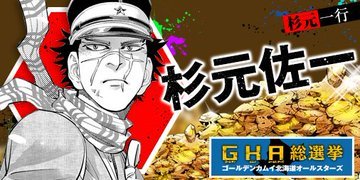
Sugimoto Saichi (杉元 佐一) - Nicknamed ‘Fujimi no Sugimoto’ (不死身の杉元 “Sugimoto the Immortal”).
Sugimoto Saichi: He uses ‘Ore’ (俺 “I”) to talk about himself (Chap 1). Sometimes, when in danger, he also refers to himself by his nickname ‘Fujimi no Sugimoto’ (不死身の杉元 “Sugimoto the Immortal”) (Chap 2). When talking with Makanakkuru he defines himself as ‘Wajin’ (和人 “Japanese”) (Chap 13). Talking with Henmi he comments if he has to he won’t hesitate to become an ‘Oni’ (鬼 “Demon”) (Chap 39)
Sugimoto & others: Talking with Asirpa he refers to himself and Shiraishi as ‘Ore-tachi’ (俺たち “We”) (Chap 27). Talking about himself and Kiroranke he says they’re ‘Nichirosensō kaeri’ (日露戦争帰り “Russo-Japanese war returners/veterans”) (Chap 49).
Asirpa: When he first sees her he just refers to her as an ‘Ainu’ (アイヌ). Then, to talk with her, in the beginning he uses only ‘Anta’ (あんた “You”) to call her (chap 1) but later he will also start to use ‘Asirpa-san’ (アシリパさん) (Chap 2). When referring to her in front of Tamai’s group he calls her ‘Ainu no gaki’ (アイヌのガキ “Ainu brat”) (Chap 9). When she calls him stupid he calls her ‘hidoi’ (ヒドーイ “Mean”) (Chap 13). Saying Tanigaki can’t use her as a human shield he calls her ‘Sono ko’ (その子 “This child”) (Chap 28) and says he can’t use her as a ‘Tate’ (盾 “Shield”) (Chap 28). When saying Asirpa wants to save Tanigaki he calls her ‘Ore no aibō’ (俺の相棒 “His partner”) (Chap 30). When Henmi asks him why he’s with her he calls her ‘kono ko’ (この子 “This child”) (Chap 39).
Gifutarō: When meeting him a second time Sugimoto calls him ‘Dekabutsu’ (デカブツ “Huge guy”) (Chap 15).
Gotō: In the beginning he uses ‘Anta’ (あんた “You”) to call him (chap 1). When he discovers he was one of the prisoners he calls him ‘Kono Oyaji’ (このオヤジ “Old bastard”) (Chap 1). In front of Asirpa he’ll call him ‘Kono Hito’ (この人 “This man”) (Chap 2). Talking about the skins they have he refers to him as ‘Sake de jinsei kurutta ossan’ (酒で人生狂ったオッサン “Old man who ruined his life with booze”) (Chap 47)
Henmi Kazuo: Talking about him Sugimoto calls him ‘Henmi��� (Chap 38). Later he thinks at him as a ‘Gokuakunin’ (極悪人 “Scoundrel”) (Chap 38). When promising him he’ll think at him he calls him ‘Omae’ (お前 “You”) (Chap 41). When the orca takes him he says they’ve to get ‘Henmi Kazuo’ back (Chap 41). As he comments he saw him gleaming in the end he calls him ‘Omae’ (おまえ “You”) (Chap 41). Talking about the skins they have he refers to him as ‘Nishin-ba ni ita renzoku satsujinki no ossan’ (ニシン場にいた連続殺人鬼のオッサン “The old serial killer at the herring fishery”) (Chap 47)
Hijikata Toshizō: Asking info about him he calls him ‘Oyadama’ (親玉 “leader”) (Chap 7). Seeing him in the worker lodge he calls him ‘Hen'na jī-san’ (変なジイさん “Weird old man”) (Chap 44). Talking about him he calls him first ‘Hijikata’ then ‘Hijikata Toshizō’ (Chap 47)
Huci: Meeting her he calls her ‘Obā-san’ (お婆さん “Grandmother”) (Chap11) but then he later switches to ‘Obā-chan’ (お婆ちゃん “Grandmother”) (Chap 13).
Ienaga Kano: When she tries to lick Asirpa’s eyeballs he calls her ‘Temee’ (てめえ “You”) (Chap 53) and then ‘Yōkai medama name’ (妖怪目玉舐め“Eyeball licking monster”) (Chap 53). When he’s told she is Chicanobu he calls him a ‘Jijī’ (ジジイ “Old man”) (Chap 53). When she escapes he calls her ‘Okami’ (女将 “Proprietress”) (Chap 53). Saying she was on the second floor with Ushiyama he calls her ‘Ienaga’ (Chap 55).
Kiroranke: Meeting him he asks him if he is ‘Tsurumi chūi no teshita’ (鶴見中尉の手下 “First Lieutenant Tsurumi’s minion”) (Chap 48). Later he calls him ‘Anta’ (アンた “You”) (Chap 48). Later on he’ll calls him ‘Anta’ (あんた “You”) but this time is written in Hiragana (Chap 49). When telling Shiraishi he’s hiding something, he calls him ‘Kiroranke’ (Chap 49).
Nihei Tetsuzō: When explaining Shiraishi has to tag along so they can recognize him he calls him ‘Nihei Tetsuzō’ (Chap 26). Talking about the skins they have he refers to him as ‘ Saigo no ōkami o otte ita ryōshi no ossan’ (最後の狼を追っていた猟師のオッサン “The old hunter who was chasing the last wolf”) (Chap 47)
Nikaidō Yōhei: When he says he’ll mark him he calls him ‘Omae’ ( おまえ “You”) (Chap 17). Attacking him before killing him he calls him ‘Hanuke yarō’ (歯抜け野朗 “Missing tooth guy”) (Chap 18).
Ogata Hyakunosuke: When Ogata removes his coat Sugimoto calls him simply a ‘Heishi’ (兵士 “Soldier”).
Osoma: When he asks her for her name he calls her ‘Ojō-chan’ (お嬢ちゃん “Miss”) (Chap 12). Later, when talking with her father, he calls her ‘Osoma-chan’ (オソマちゃん).
Retar: First seeing him Sugimoto calls him a ‘Yaken’ (野犬 “Wild dog”) as that’s what he thought Retar was (Chap 2) and also referred to him as a ‘Dekai Shiroi Inu’ (デカイ白い犬 “Huge white dog”) (Chap 2). When seeing him with Asirpa after his confrontation with Tamai group he calls him ‘Shiroi Ookami’ (白いオオカミ “White Wolf”) and then just ‘Ookami’ (オオカミ “Wolf”) (Chap 11). When seeing Retar running after the deer he missed he calls him just ‘Retar’ (Chap 24) .
Ryū: He calls him ‘Ryū’ and ‘Orikō-san’ (おりこうさん “Mister well-behaved one”) (Chap 36).
Shiraishi Yoshitake: When they capture him with the squirrel trap he labels him ‘Nibikime’ (二匹目 “the second small animal”) they captured (Chap 6). He then calls him ‘Omae’ (お前 “You”) (Chap 6). When Shiraishi is trying to escape he calls him ‘Kono yarō’ (この野郎 “You bastard”) (Chap 6). When Shiraishi tries rub a huge piece of wood to make a fire he calls him ‘Aho’ (アホ “Idiot”) (Chap 7). Then, when searching for the cartridges in the river calls him ‘Temē’ (テメー “You”) (Chap 7). After they talk though, he starts to call him ‘Shiraishi’ (Chap 7). When he sees him slipping in his cell through the bars he calls him ‘Yōkai’ (妖怪 “Ghost/Monster”) (Chap 18). When scolding him for not bringing up Nihei was searching for a white wolf sooner Sugimoto calls him ‘Temē’ (てめー “You”) (Chap 26). When Shiraishi can’t find the way Tanigaki went he calls him ‘Aho’ (アホ “Idiot”) (Chap 28). Talking about the skins they have he refers to him as ‘ Datsugoku shite wa tsukamaru dojina ossan’ (脱獄しては捕まるドジなオッサン “The clumsy old guy who escapes from prison only to get caught again”) (Chap 47). When he calls in the water he calls him ‘Kono baka’ (このバカ “this idiot”) (Chap 47) and ‘Yakudatazu’ (役立たず“Useless”) (Chap 47) and once he was fished back he called him ‘Ningyo’ (人魚 “Mermaid”) (Chap 47). Saying he might have gone to Susukino he calls him ‘ Ano ero bōzu’ (あのエロ坊主 “That pervert bald head”) (Chap 55).
Soldiers of the 7th: While talking with the Nikaidō twins he calls the other soldiers their ‘Onakama’ (仲間 “Buddies”) (Chap 18), while when talking with them he calls them ‘Omae-ra’ (お前ら and おまえら “You (plural)”) (Chap 18).
Sugimoto-tachi o Bikō Shite Ita Shūjin: When they capture him with the squirrel trap he claims he is the ‘Itsupikime’ (一匹目 “the first small animal”) they captured (Chap 3). Talking about the skins they have he refers to him as ‘Dainanashidan ni o uchinuka reta ossan’ (第七師団にを撃ち抜かれたオッサン “The old man shot by the seventh division”) (Chap 47)
Tanigaki Genjirō: When he sees him lying on the ground Sugimoto calls him simply a ‘Heishi’ (兵士 “Soldier”) (Chap 11). Seeing him holding Asirpa as obstage he calls him ‘Kisama’ (きさま “You”) (Chap 28). When asking her if she’s really bringing him to her village he keeps on calling him ‘Koitsu’ (こいつ “This guy”) (Chap 29) When Tanigaki tells them to let him die he calls him ‘Tanigaki’ (Chap 30).
Toraji: He calls him ‘Toraji’ (Chap 1). Talking about Toraji with Asirpa he calls him first ‘Osananajimi’ (幼なじみ “childhood friend”) then switches to ‘Senyū’ (戦友 “comrade in arms/war buddy”) (Chap 1). Asking him if he really left his wife alone to see him he calls him ‘Omae’ (お前 “You”) (Chap 35).
Tsurumi Tokushirō: Talking with the Nikaidō brothers he calls him ‘Omae-ra no Taishō’ (お前らの大将 “Your commander”) (Chap 16). When thinking he should have pretended to join him he calls him ‘Ano Tsurumi toka iu chūi’ (あの鶴見とかいう中尉 “That lieutenant Tsurumi or whatever”) (Chap 17). When talking with Tanigaki he calls him ‘Tsurumi chūi’ (鶴見中尉 “First Lieutenant Tsurumi”) (Chap 30).
Umeko: Talking about her with Toraji he uses ‘Umeko’. Calling her he uses ‘Ume-chan’ (梅ちゃん) (Chap 1). When talking with Ogata about why he’s searching the gold he calls her ‘Horeta Onna’ (惚れた女 “the woman he fell in love with”) (Chap 5). He however calls her ‘Omae’ (お前 “You”) when he tells her to marry Toraji (chap 6). Talking with Toraji about her he calls her ‘Hanayome’ (花嫁 “Bride”) (Chap 35).
Ushiyama Tatsuma: The first time he sees him he calls him ‘Anta’ (アンた “You”) (Chap 52) and when he tries to cause him to lose balance he mentally calls him ‘kono ossan’ (このオッサン “This old man”) (Chap 52). After he tells Asirpa which sort of man she has to pick he calls him ‘Sensei’ (先生 “Teacher”) (Chap 52). While they fight he calls him ‘Kono yarō’ (コノ野郎 “This bastard”) (Chap 54). Wondering if he died in the explosion he calls him ‘Ushiyama’ (Chap 54).
Wilk: He calls him ‘Nopperabō’ (のっぺら坊 “Faceless male”) as this was how Sugimoto-tachi o Bikō Shite Ita Shūjin told him he was called (Chap 6). Learning he might be Asirpa’s father he calls him ‘Asirpa-san no chichioya’ (アシリパさんの父親 “Asirpa’s father”) (Chap 48)
Others: He calls Tamai, Noma and Okada ‘Anta-ra’ (あんたら “You (plural)”) (Chap 9) and then just ‘Henshi-tachi’ (軍士たち”Soldiers”) (Chap 17). He calls Nikaidō Kōhei and Yōhei ‘Omae-ra’ (お前ら and おまえら “You (plural)”) (Chap 16) and, referring to them after their fight, he calls them ‘Ano futago’ (あの双子 “Those twins”) (Chap 18). He calls Tsurumi and his men ‘Anta-ra’ (あんたら “You (plural)”) (Chap 16).

Sugimoto-tachi o Bikō Shite Ita Shūjin (杉元達を尾行していた囚人 “Prisoner who was tailing Sugimoto’s group”) better known by the fandom as Prisoner number 1 (囚人番号一 Shūjin Bangō Ichi).
Sugimoto-tachi o Bikō Shite Ita Shūjin: He uses ‘Ore’ (俺 “I”) to talk about himself (Chap 4). When he compares himself to the other prisoners he defines himself as a ‘Koakutō’ (小悪党 “Small villain”) (Chap 4).
Hijikata Toshizō: He calls him a ‘Kaibutsu’ (怪物 “Monster”) (Chap 4).
Sugimoto Saichi: He calls him ‘Nī-chan’ (にーちゃん “Older brother/young man”) (Chap 4).
Wilk: He claims everyone called him ‘Nopperabō’ (のっぺら坊 “Faceless male”) as he didn’t have a face (Chap 4).

Tamai (玉井) - Rank: ‘Gochō’ (伍長 “Corporal”).
Asirpa: Talking about her he calls her ‘Kodomo’ (子供 “Child”) (Chap 9).
Ogata Hyakunosuke: Talking about him he calls him ‘Ogata Jōtōhei’ (尾形上等兵 “Superior Private Ogata”) (Chap 8).
Sugimoto Saichi: He uses ‘Kisama’ (きさま “You”) to call him and then ‘Sugimoto’ (Chap 9). When warning his men to keep distance he calls him ‘Fujimi no Sugimoto’ (不死身の杉元 “Sugimoto the Immortal”) (Chap 10).
Tanigaki Genjirō: Talking about him he calls him ‘Tanigaki’ (Chap 9). Talking with him he uses ‘Omae’ (お前 “You”) (Chap 44)
Tsurumi Tokushirō: Talking about him he calls him ‘Tsurumi Chūi’ (鶴見中尉 “First Lieutenant Tsurumi”) (Chap 44).
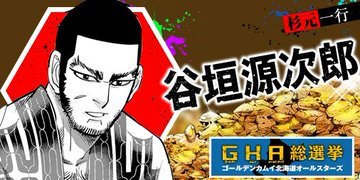
Tanigaki Genjirō (谷垣 源次郎) - Rank: ‘Ittōhei’ (一等兵 “Private First Class”).
Tanigaki Genjirō: He uses ‘Ore’ (俺 “I”) to talk about himself (Chap 9). He also defines himself as a ‘Tōhoku Matagi’ (東北マタギ “Matagi of Tohoku”) (Chap 9). When he tells Asirpa to leave him die he defines himself a ‘Ryōshi’ (猟師 “Hunter”) (Chap 30).
Tanigaki Genjirō & others: Talking about himself and Nihei he uses ‘Ore-tachi’ (俺たち “We”) (Chap 25). Talking about himself and the Matagi he uses ‘Ore-tachi’ (俺たち “We”) (Chap 25). Talking about himself and the soldiers of the 7th he uses ‘Ore-tachi’ (おれたち “We”) (Chap 30).
Asirpa: Talking about her he calls her ‘Kodomo’ (子供 “Child”) (Chap 9) and, seeing she tried concealing her steps he called her ‘Kashikoi Ko’ (賢い子 “Clever child”) (Chap 9). While talking with her he calls her ‘Ojō-chan’ (お嬢ちゃん “Miss”) (Chap 9). Talking about her bond with Retar he calls her ‘Shōjo’ (少女 “Girl”) (Chap 25). Holding her as hostage he calls her ‘Kono musume’ (この娘 “This girl”) (Chap 28).
Hanazawa Kōjirō: Talking about him he calls him ‘Hanazawa Kōjirō Chūjō’ (花沢幸次郎中将 “Lieutenant General Hanazawa”) and says he was the ‘Kono sakusen no sanbō-chō’ (この作戦の参謀長 “Chief of staff for that operation”) and the ‘Moto dainanashidan-chō’ (元第七師団長 “7th division former chief”) (Chap 31).
Huci: After hearing the legend of the gold from her he calls her ‘Bā-san’ (ばさん “Grandmother”) (Chap 30). When Shiraishi visits him he calls her ‘Obā-chan’ (おばあちゃん “Grandmother”) (Chap 36).
Mishima: He calls him ‘Mishima’ (Chap 46) and ‘Omae’ (お前 “You”) (Chap 46).
Nihei Tetsuzō: He refers to him as a ‘Yūmeina kumauchi’ (有名な熊撃ち “Famous bear shooter”) (Chap 22) whose name was ‘Nihei Tetsuzō’ (Chap 22) and also uses ‘Anta’ (あんた “You”) to call him. (Chap 22). Talking about his rifle he calls him ‘Nihei Tetsuzō’ (Chap 44) and then just ‘Nihei’ (Chap 44).
Nikaidō Kōhei: He calls him ‘Nikaidō’ (Chap 43)
Ogata Hyakunosuke: Asking him to spare Huci and Osoma he calls him ‘Ogata Jōtōhei-dono’ (尾形 百之助上等兵殿 “Superior Private Ogata, sir”) (Chap 43). Tanigaki defines him ‘Shageki no tatsujin’ (射撃の達人 “Master Marksman”) (Chap 43). Later he refers to Ogata as just ‘Ogata Jōtōhei’ (尾形 百之助上等兵 “Superior Private Ogata”) (Chap 44).
Osoma: He calls her ‘Osoma’ (Chap 43)
Retar: He calls him a ‘Ezo Ōkami’ (エゾオオカミ “Hokkaido Wolf”) which is what Retar is (Chap 11) and then just ‘Ōkami’ (オオカミ “Wolf”) (Chap 11). He also calls him a ‘Shiroi ōkami’ (白いオオカミ “White Wolf”) (Chap 22). Talking about his bond with Asirpa he calls him ‘Ōkami’ (狼 “Wolf”) (Chap 25). Later, when talking about Retar’s behaviour he suggests he could be an ‘Okuri Ōkami’ (送り狼 “Following wolf”) (Chap 26)
Ryū: He calls him ‘Ryū’ (Chap 36) and defines him a ‘Sudeni shitsuke mo kunren mo sa reta atamanoī ryōken’ (すでにしつけも訓練もされた頭のいい猟犬 “An already well trained smart hound”) (Chap 36). Explaining Shiraishi how he should establish dominance over him he refers to him simply as the ‘Inu’ (犬 “Dog”) (Chap 36).
Tamai: Thinking about him he calls him ‘Tamai Gochō’ (玉井伍長 “Corporal Tamai”) (Chap 43)
Tsurumi Tokushirō: Talking about him he calls him ‘Ore-tachi o hikiite iru chūi’ (俺たちを率いている中尉 “The lieutenant who is leading us”) and ‘Jōhō shōkō’ (情報将校 “Information officer”) (Chap 30), then he refers to him as ‘Tsurumi Chūi’ (鶴見中尉 “First Lieutenant Tsurumi”) (Chap 30).
Tsuyama: Talking about him he calls him ‘Tsuyama’ (Chap 31).
Yodogawa Terunaka: Talking about him he calls him ‘Rentai-chō no Yodogawa chūsa’ (聯隊長の淀川中佐 “Regemental Commander Lieutenant Colonel Yodogawa”) (Chap 50).
Others: Telling Shiraishi Yoshitake & Sugimoto Saichi to drop their weapons he calls them ‘Omae-ra’ (お前ら “You (Plural)”) (Chap 28). Talking about Sugimoto Saichi and his group he calls them ‘Sugimoto-tachi’ (杉元たち“Sugimoto and the others”) (Chap 42). Talking about Ogata and those who betrayed the 7th he uses ‘Yatsu-ra’ (奴ら “Those guys”) (Chap 44) and then ‘Teki’ (敵 “Enemy”).

Thomas (トーマス).
Tsurumi Tokushirō: Talking with him he calls him ‘Tsurumi-san’ (鶴見サン) (Chap 31).
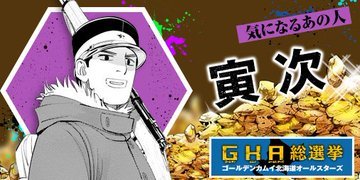
Toraji (寅次).
Toraji: He uses ‘Ore’ (俺 “I”) to talk about himself.
Sugimoto Saichi: He calls him ‘Saichi’ (Chap 1) or ‘Omae’ (お前 “You”). Talking about their relation he calls him ‘Osananajimi’ (幼なじみ “childhood friend”) (Chap 1). Talking about Umeko he says he was the one ‘Umeko no naka ni’ (梅子の中に “Inside Umeko”) (Chap 35).
Toraji’s mother: Talking about her he calls her ‘Kā-chan’ (母ちゃん “Mother”) (Chap 35).
Umeko: Talking about her with Sugimoto he calls her ‘Umeko’ (Chap 1). He also refers to her as his ‘Nyōbō’ (女房 “Wife”) (Chap 1). Talking with her he calls her ‘Umeko’ and ‘Omae’ (おまえ “You”) (Chap 35).
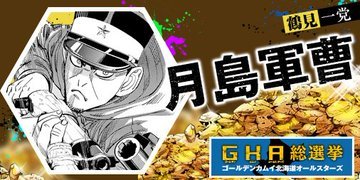
Tsukishima Hajime (月島 基) - Rank: ‘Gunsō’ (軍曹 “Sergeant”).
Mishima: He calls him ‘Mishima’ (Chap 46).
Nikaidō Kōhei: He calls him ‘Nikaidō’ (Chap 46).
Ogata Hyakunosuke: He calls him ‘Ogata’ (Chap 46).
Thomas: Talking with him he calls him ‘Thomas-san’ (トーマスさん) (Chap 31).
Tsurumi Tokushirō: Reporting the situation he calls him ‘Tsurumi Chūi’ (鶴見中尉 “First Lieutenant Tsurumi”) although short after he uses ‘Tsurumi Chūi-dono’ (鶴見中尉殿 “First Lieutenant Tsurumi, sir”) (Chap 34).

Tsurumi Tokushirō (鶴見 篤四郎) - Rank: ‘Chūi’ (中尉 “First Lieutenant”).
Tsurumi Tokushirō: He uses ‘Watashi’ (私 “I”) to talk about himself (Chap 16) however when he says he’ll bite Sugimoto’s candle he uses ‘Ore’ (俺 “I”) to talk about himself (Chap 16). Talking with Sugimoto he’ll also defines himself ‘Omae no Shinigami’ (お前の死神 “Your God of Death/Your reaper”) (Chap 16).
Hanazawa Kōjirō: He calls him ‘ Dai-nana Shidan no Shidan-chō’ (第七師団の師団長 “Division chief of the 7th division”) and ‘Hanazawa chūjō’ (花沢中将 “Lieutenant General Hanazawa”).
Hijikata Toshizō: Seeing him outside the bank he calls him ‘Hijikata Toshizō’ (Chap 34), then he defines him ‘Bakumatsu no bōrei’ (幕末の亡霊 “The departed spirit of the Bakumatsu”) (Chap 34) then corrects himself and says he is a ‘Kono yo ni urami o nokoshita akuryō-me’ (この世に怨みを残した悪霊め “Evil spirit stuck in this world due to a grudge”).
Nikaidō Kōhei: He calls him ‘ Nikaidō’ (Chap 46), then ‘Omae’ (お前 “You”) (chap 46), Uragirimono (裏切り者 “Traitor”) and then ‘Kisama’ (貴様 “You”) (Chap 46).
Nikaidō Yōhei: Studying his corpse he calls him ‘Kisama’ (貴様 “You”) (Chap 19).
Ogata Hyakunosuke: Talking about him, first he refers to him as his ‘Buka’ (部下 “Subordinate”), then he calls him ‘Ogata Jōtōhei’ (尾形上等兵 “Superior Private Ogata”) (Chap 16). Pondering about him he calls him ‘Ogata Hyakunosuke’ (Chap 58) and talking about his family just ‘Hyakunosuke’ (Chap 58)
Ogata Hyakunosuke no haha (尾形 百之助の母 “Ogata Hyakunosuke’s mother”): Talking about her with Nikaidō he says she was Hanazawa’s ‘Mekake’ (妾 “Mistress”) (Chap 58).
Soldiers of the 7th: Talking to them he calls them ‘Omae-tachi’ (おまえたち “You” (plural)) (Chap 31).
Sugimoto Saichi: He uses ‘Omae’ (お前 “You”) to call him (chap 16), then he’ll use ‘Fujimi no Sugimoto’ (不死身の杉元 “Sugimoto the Immortal”) when he’ll try to confirm his identity (Chap 16). When he orders to keep the twins away from him he calls him simply ‘Sugimoto’ (Chap 18).
Tanigaki Genjirō: he calls him both ‘Tanigaki’ and ‘Matagi’ (マタギ “Matagi”) (Chap 13).
Wada: he calls him ‘Wada Taii-dono’ (和田大尉殿 “Captain Wada, sir”) (Chap 13).
Wilk: Talking about him he calls him ‘Nopperabō’ (のっぺら坊 “Faceless male”) (Chap 30).
Others: When saying to keep Nikaidō Kōhei and Yōhei far from Sugimoto he calls them ‘Ano kyōdai’ (あの兄弟 “Those brothers”) (Chap 18). Talking about Asirpa, Shiraishi Yoshitake and Sugimoto Saichi he calls them ‘Sugimoto Ichimi’ (杉元一味 “Sugimoto group”) (Chap 19).
Tsuyama (津山).

Umeko (梅子).
Umeko: When talking about herself with her child she calls herself ‘Okā-chan’ (お母ちゃん “Mother”) (Chap 15), while talking with Sugimoto she uses ‘Watashi’ (わたし) (Chap 15). Talking about how she’ll escape from Sugimoto she uses ‘Watashi’ (私 “I”) (Chap 35).
Toraji: Talking with him about Sugimoto he calls him ‘Toraji-san’ (寅次さん) (Chap 35) but then switches to ‘Tora-chan’ (トラちゃん) (Chap 35).
Sugimoto Saichi: Calling him she uses ‘Saichi-chan’ (佐一ちゃん) (Chap 1). When she can’t recognize him she uses ‘Anata’ (あなた “You”) (Chap 15). Talking with Toraji about him he calls him ‘Saichi-san’ (佐一さん) (Chap 35).
Umeko’s mother: She calls her ‘Okā-san’ (お母さん “Mother”) (Chap 35).

Ushiyama Tatsuma (牛山 辰馬) - Nicknamed ‘Fuhai no Ushiyama’ (不敗の牛山 “Ushiyama the Undefeated”).
Ushiyama Tatsuma: He uses ‘Ore’ (オレ “I”) to refer to himself (Chap 37).
Asirpa: He calls her ‘Ojōchan’ (お嬢ちゃん “Lady”) (Chap 37).
Henmi Kazuo: Talking about him with Nagakura he calls him ‘Henmi Kazuo’ and ‘Yatsu’ (ヤツ “That guy”) (Chap 37).
Hijikata Toshizō: When he sees him he calls him ‘Hijikata no Jijī’ (土方のジジイ”Old man Hijikata”) but then switches to ‘Jī-san’ (爺さん “Grandfather/old man”) (Chap 12). He later settles on calling him ‘Jijī’ (ジジイ “Old man”) (Chap 21). When he sees him killing though he acknowledges he’s the true face of the Shinsegumi ‘Oni no Fukuchō’ (鬼の副長 “Demonic vice-commander”) (Chap 21) He calls him ‘Anta’ (あんた “You”) when he asks him if he plans to make a new Shinsengumi (Chap 21). Talking about Murahashi and Hijikata he calls him first ‘Hijikata Toshizō’ (Chap 52) then ‘Hijikata no yarō’ (土方の野郎“that bastard Hijikata”) (Chap 52).
Ienaga Kano: Seeing her he says she is a ‘Ii onna’ (いい女 “Fine woman”) (Chap 50) then starts calling her ‘Okami’ (女将 “Proprietress”) (Chap 51). When thinking at her as Chicanobu he calls him a ‘Jijī’ (ジジイ “Old man”) (Chap 51). Telling her to say what she knows to SHiraishi he calls her ‘Ienaga’ (Chap 55).
Nagakura Shinpachi: When he first hears his name, first he repeats it, then he calls him ‘Kono Jijī’ (このジジイ “That old man”) (Chap 20) then wonders if he is the ‘Shinsengumi saikyō kenshi’ (新選組最強剣士 “Shinsengumi strongest swordman”) or more specifically ‘Nagakura Shinpachi’ (Chap 20). Talking with Hijikata about the info he received, he calls him ‘Nagakura’ (Chap 21). As Nagakura threaten to cut him in a half he calls him ‘Shinsengumi de ichiban to utawa reta kengō no sako ka’ (新選組で一番と謳われた剣豪の迫カ “The swordman whose martial arts were described as being the best in the Shinsengumi”) (Chap 33).
Nihei Tetsuzō: Talking about Henmi he calls him ‘Nihei Tetsuzō’ (Chap 37).
Shiraishi Yoshitake: Seeing him in front of the brothel he calls him ‘Shiraishi Yoshitake’ (Chap 33) though moments afterward he calls him simply ‘Shiraishi’ (Chap 33). When Shiraishi stabs his forehead with a nail he calls him ‘Shiraishi-kun’ (シライシくん) (Chap 37). Ushiyama defines him someone who looks like a ‘Ahotsura’ (アホ面 “Stupid face”) but who’s actually a ‘Yudan dekinai yōkai’.
(油断できない妖怪 “Apparition/Monster with whom you can’t be careless”) (Chap 37). Telling him they’ll let him live if he’ll let them copy his tattoo he calls him ‘Omē’ (オメー “You”) (Chap 37). Asking how he got a copy of Henmi’s tattoo he’ll use ‘Omae’ (お前 “You”) (Chap 55) and call him a ‘Dojikko’ (ドジっ子 “Clumsy person”) (Chap 55) to switch to ‘Temē’ (てめえ “You”) when he tells him he’s better not try to trick them (Chap 55).
Sugimoto Saichi: Realizing who he is he calls him ‘Fujimi no Sugimoto’ (不死身の杉元 “Sugimoto the Immortal”) (Chap 54).
Others: When he realize Hijikata Toshizō and Nagakura Shinpachi are both ex-Shinsengumi members he calls them ‘Shinsengu no oibore-domo’ (新選組の���いぼれ共 “You Shinsengumi ex-members”) and then ‘Anta-ra’ (あんたら “You (plural)”) (Chap 20). Saying he’ll head off for a bit he calls them ‘Oibore-tachi’ (老いぼれたち “Old guys”) (Chap 33).
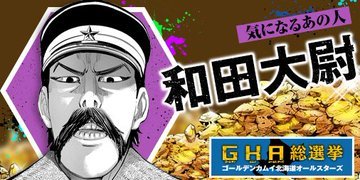
Wada (和田) - Rank: ‘Taii’ (大尉 “Captain”).
Wada: He uses ‘Watashi’ (私”I”) to talk about himself (Chap 13).
Tsurumi Tokushir��: He calls him ‘Tsurumi’ and also ‘Kisama’ (貴様 “You”) (Chap 13).

Wilk (ウイルク/Вилк) - Nicknamed ‘Nopperabō’ (のっぺら坊 “Faceless male”).
Asirpa: He calls her ‘Asirpa’ (アシㇼパ) (Chap 21). Talking about her with the convicts he calls her ‘Kochōbe Asuko’ (Chap 48).

Yamamoto (山本).
Chiyoko: Talking about her with Hijikata and Nagakura he calls her ‘Hidoro no Mekake’ (日泥の妾 “Hidoro’s Mistress”) (Chap 56).
Ejiri Matasuke: He says he is ‘Keisatsu Shochō’ (警察署長 “Police chief”) (Chap 55) and calls him just ‘ Shochō’ (署長 “Chief”) (Chap 55).
Hidoro Tamotsu: He say he is ‘Chīsana nishin-ba no Hidoro’ (小さなニシン場の日泥 “Hidoro from the small herring fishery”) and defines him as the ‘Oyakata’ (親方 “Boss”) of the ‘Toba’ (賭場 “Gambling place”) (Chap 55)
Hijikata Toshizō: He asks him if he’s a ‘Yōjinbō’ (用心棒 “Bodyguard”) (Chap 55)
Kusuda Umakichi: He calls him ‘Kusuda Umakichi’ (Chap 55) and says he was Hidoro’s ‘Ichiban no kobun’ (一番の子分 “Right hand man”) (Chap 55). Later he calls him just ‘Umakichi’ (Chap 55).
Nagakura Shinpachi: He asks him if he’s a ‘Yōjinbō’ (用心棒 “Bodyguard”) (Chap 55)
Ogata Hyakunosuke: He calls him ‘Anta’ (あんた “You”) (Chap 55).
Others: He calls Hijikata and Nagakura ‘Anta-ra’ (あんたら “You” (Plural)) (Chap 55).
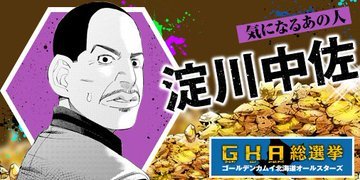
Yodogawa Terunaka (淀川 輝前) – Rank: ‘Chūsa’ (中佐 “Lieutenant Colonel”).
Nuances in the words used to say ‘I’
.
Atashi (あたし or アタシ): The “I” which is an informal effeminate form of watashi. It has a kind of “cute” nuance to it. Because kanji are generally seen as masculine, this word has no kanji form. It is written in either hiragana or katakana.
Boku (僕): The “I” which gives a masculine impression. Perceived as humble, but can also carry an undertone of “feeling young” when used by males of older age. Also used when casually giving deference; “servant” uses the same kanji (僕 shimobe). Can also be used as a second-person pronoun toward male children (English equivalent - “kid” or “squirt”); it is typically used by males, especially those in their youth.
Ore (俺 orおれ): The masculine way to say “I”. This is the word tough guys use, and as such it’s almost never used with a polite verb form. It’s worth to note though that it was also the way soldiers would say “I”, though since Sugimoto and Toraji used it prior to join the army I guess it doesn’t matter.
Watashi (私 or わたし): The standard, gender-free way to say “I”.
Nuances in the words used to say ‘you’
.
Anata (貴方 or あなた): The most common, average, regular-looking, no-nuance second person pronoun of the language. Basically you’d use anata is when you don’t know someone’s name.
Anta (あんた or アンタ): The “you” which is a shortened version of anata, highly informal and generally rude or admonishing in nature.
Kisama (貴様 or きさま): The “you” who’s currently rude, usually used between enemies and by Japanese males when angry. In old Japan it was actually a term of respect though and, later, it was commonly used among soldiers to talk to each other.
Omae (お前 or おまえ): The “you” used in very informal situations or toward people of lower status. This word feels very “blunt” and can easily come off as rude.
Temē (手前 or テメー or てめえ): The “you” rude and confrontational. Literal meaning “the one in front of my hand”. It’s a reduction of temae and it’s ruder. Used when the speaker is very angry. Originally used for a humble first person. The Kanji are seldom used with this meaning, as unrelated to its use as a pronoun, 手前 can also mean “before”, “this side”, “one’s standpoint” or “one’s appearance”.
Plural suffixes
.
-domo (ども): It used as a first-person plural it’s humble (Examples: watashi-domo) while if uses as second or third person plural implies the speaker is of higher status than those referred to and can sound derogatory. Basically it can make people’s position low, and can even be used to insult people. Usually written using kana alone. (Examples: Omae-domo, Shinsengu no oibore-domo).
-gata (方 or がた): Roughly it means “Et alia”. It’s used to turn a word into a plural but it’s also more honorific and respectful than -tachi. Basically it can make people’s position high, so it will sound weird if you use it instead than ‘-tachi’ with those who belong to your community. (Examples: Osamurai-san-gata, Danna-gata).
-ra (等 or ら): Roughly it means “Et cetera”. It’s used to turn a word into a plural but it’s rather casual and therefore slightly more rude than -tachi so it should usually only be used with family or the first person unless you have a specific reason for it or you might sound deprecating. (Examples: Anta-ra, Omae-ra).
-tachi (達 or たち): Roughly it means “And the others”. It’s used to turn a word into a plural (Examples: Anta-tachi, Omae-tachi, Henshi-tachi).
Honorific suffixes
.
-Chan (ちゃん): A diminutive suffix; it expresses that the speaker finds a person endearing. Also used to speak about children or among childhood friends.
-Dono (どの or 殿): Roughly means “lord” or “master”. It does not equate noble status; rather it is a term akin to “milord”, and lies below -sama in level of respect. It was also used in place of “sir” in the army.
-Kun (くん or 君): Generally used by people of senior status addressing or referring to those of junior status.
-San (さん): The most commonplace honorific and is a title of respect typically used between equals of any age. Although the closest translations would be “Mr.”, “Miss”, “Ms.”, or “Mrs.”, -san is almost universally added to a person’s name and can be used in formal and informal contexts for both genders.
16 notes
·
View notes
Quote
My father gave me the name 'Asirpa.' It means 'a new year.' But it can also mean 'the future.' I am an Ainu girl for a new era.
Asirpa, Golden Kamuy
27 notes
·
View notes
Text
to gold be the gory
How Golden Kamuy Outshines Competition
A Review
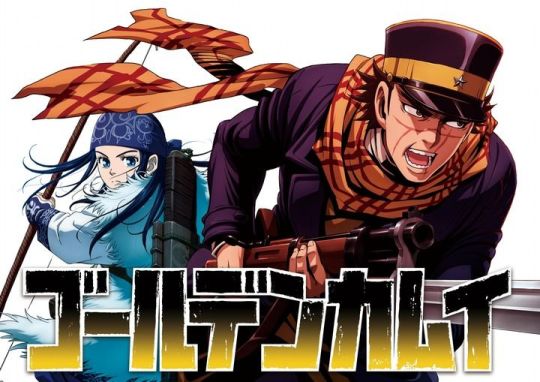
-
“GORUDEEEEEEN KAMUUUUUUY!”
That’s how I first heard of Golden Kamuy – a male voice screaming its title in around 2-minute intervals. I was busy slurping ramen in the communal eating tent in Odori Park when it blared in my ear. All through the day, they played its trailer on the tent TVs over and over again. It seemed interesting, and it was quite apt to see it being promoted there - after all, we were surrounded by snow, in Hokkaido, where the story was set. I kept seeing it in bookstores and its artwas eye-catching. But as soon as I was back on home soil, my interest was gone.
Life caught right back up with me, so I forgot about Golden Kamuy completely. Not until I saw some artists I follow post amazing fan art of it on Twitter. They were all singing it praises and the official art was beautiful, so I thought, ‘aw heck, why not?’
Let me tell you: there are no reasons not to.
SUGIMOTO, THIS ISN’T SHOUNEN ANYMORE
I’m what you call a…sporadic manga reader. I’m not up to speed with manga trends and it can take me a while to catch up. I read stuff that get my attention and when they’re recommended by my friends (I still haven’t touched Boku no Hero Academia or Shokugeki no Soma, though). I also don’t limit myself to just one genre. There are months that I devour shoujo/josei manga, like Hana Nochi Hare and Dame na Watashi ni Koi wo Kudasai. Then I’d switch over to read through volumes upon volumes of shounen manga (hi, Gintama, Haikyuu). Then there are periods wherein I just don’t read at all, devoting my time to other activities instead.
Golden Kamuy, brainchild of artist Noda Satoru, is probably my first real foray into the seinen manga territory. The art, the storyline, the comedy, the stakes – every page told me that I wasn’t reading shounen anymore. Dick jokes weren’t dealt with caution. Gore was done with no shame. Raw Japanese scans didn’t have the hiragana reading aids. Strangely enough, it brought me back to all the titles I used to read when I was young. It made me realize all the stuff I was reading back then were very edgelord-esque and middle-school-syndrome-ish - the stuff of nightmares. Body horror, violence, gore, debauchery – CLAMP and Kaori Yuuki had primed my teenage self for all of them.
But at least, now, the edginess was dealt with a more mature hand.
Hence it was no surprise that Kamuy ignited a sense of familiarity. I had mellowed down when I grew up (it saddens me that I really am quite a grown-up now) and, in turn, settled for fun, cheerful, romantic manga (to keep the dreariness of everyday life away, I guess haha). I got used to leisurely pacing and lighthearted comedy. Reading Golden Kamuy felt like I skydived into the unforgiving arena I had left – an arena that had been made fresher, better.
SO FRESH, YOU’RE EATING IT RAW
What makes Kamuy an instant hit is its interesting combination of rarely-used elements. Post-War, Meiji-Era historical, early 1900s, hunting, Hokkaido, Ainu culture: can you really find another title that uses said mix? It’s no wonder people are attracted to the series.
It also helps that the art is just spectacular. Noda’s artistic skill shines through every page, chapter, and volume cover. His poses are dynamic, his coloring brave. Sometimes the color combinations he uses just scream modern, serving as nice contrasts to the story’s historical, traditional setting. His character designs are unique and fresh – more so their personalities. Sugimoto’s facial scars are refreshing to the eye; Tsurumi’s half-corrupted face paired with a metal plate is a design I’ve never seen before. His art style brings out his designs to life in a way only he can – we’ve all seen cross-dressing men and shaved-bald convicts before, but still he was able to make Ienaga and Shiraishi look striking.
The research that he has done to make the story believable is commendable. He even has his own Ainu and Russian language consultants. Each detail he adds in shows that every page is a product of hard work. He even features real buildings in Hokkaido and Otaru (I’ve also been to Otaru and it was nice to see it in the manga!). The information we learn from Noda’s usage of the Ainu culture, hunting practices, and military details – all of this, weaved in with an intricate, explosive plot, give us a series that feels…whole. Complete.
Kamuy also spreads word about the Ainu culture in a fun and entertaining way. I haven’t heard a lot about them in the series I’ve encountered – I’ve only heard of them through Rurouni Kenshin. Nothing since then. To see them in the spotlight is a breath of fresh air. Even the Ainu themselves feel the same way – apparently they told Noda that they didn’t want to be portrayed as discriminated anymore. They wanted strong Ainu characters, and boy, did Noda deliver.
NO-PARDON PLOTTING
Because of its seinen status, you can tell that Noda has no qualms about plotting and story structure. We’re given heavy-hitting story elements right off the bat: war vet undertakes a legendary treasure hunt to help the (stolen-by-his-friend) love of his life, requiring him to track down 24 of the most dangerous insane criminals to have ever walked Japan. It’s throwing punches right from the get-go. Kamuy doesn’t baby anyone (except for bear cubs). With its pacing, convoluted plot and bevy of interesting characters, it challenges the reader to not just enjoy, but to keep up. It’s unapologetic in everything that it does – character, story, and art.
CHARACTERS
Immortal War Vet, Morality Pet Minority Action Girl, Escape Sweet-tooth King, and so forth. They somehow fulfill stereotypes but at the same time, Noda manages to twist things to a whole new light. His milieu, too, aids in solidifying the characters he writes – the setting itself makes them unforgettable.
It is also in his cast that we see how unapologetic Noda is. Considering that Sugimoto is to track 24 of the most dangerous criminals in the country, Noda doesn’t shy away from showcasing every kind of evil that can exist within humans. We tackle lust, greed, wrath, and avarice with a dash more reality compared to the caricatures we often see in shounen manga. Those faint of heart and innocent countenance will have a hard time stomaching Noda’s cast as it unfolds. The more I read, the more I believe Noda probably has a subscription to the Crime Investigation channel (which isn’t necessarily a bad thing). Truth be told, humans are very much capable of evil, and I’m not surprised that some of his villains are actually modeled after real-life criminals.
Notable characters:
IENAGA - a cross between Erszebet Bathory (a countess who was known to kill virgins and bathed in their blood to remain beautiful) and of H.H. Holmes, a real-life owner of an actual murder hotel in the US during the 19th century. Ienaga’s first dungeon appearance made me flashback to some of mangaka Kaori Yuki’s ornate gorefests such as Count Cain, Angel Sanctuary, and Ludwig Revolution. Noda felt no shame when he drew each and every one of Ienaga’s murderscapes.
HENMI KAZUO – this one really made me blink when I was reading it. Serial killer Henmi Kazuo is an exploration of the depths of human depravity. Imagine, being stimulated by gore and the act of clinging to life the same way his brother did when a bear ate him. Damn, writing that sentence made me realize Noda just straight up doesn’t baby his audience. This is the stuff Netflix series Mindhunter would kill to have. This also would really need some real guts (pardon the pun) to execute.
SHITON – he also made me stop in my tracks. Shiton, a full-on bestiality-practicing scientist, was something I’ve never read about in any other manga at all. I’ve read about murderers and criminals and incestuous personalities (Kaori Yuki and George RR Martin weren’t shy about it at all), but this character was just sick. He’s a special type of crazy (although to be perfectly honest I am sure that somewhere in the world some sick human is partaking in stuff like this), and for Noda to actually use him in his manga just takes courage. He just has the balls to make you think twice, but hey, when you’re in seinen territory, everything seems to be a free-for-all. And let’s be real frank here – there’s just another level of human debauchery in real life that most people won’t even be able to stomach hearing about.
TSURUMI – Tsurumi is the stuff of legend. He reminds me the most of Col. Hans Landa in Quentin Tarantino’s Inglorious Basterds, but with his insanity turned up into eleven. He also has shades of Leonardo’s character in Django Unchained, as well as other manic-type ‘villains’ that we’ve seen in other series. But his impulsiveness and flamboyant nature places him a cut above the rest. Noda also draws him so dynamically (seriously!) that whenever he appears, your eyes are just drawn to him.
Plus, I have to say that I’m really impressed with the level of real-world research that Noda uses in developing his characters. Tsurumi says that he has lost a part of his frontal lobe, which in turn affects his temper and his violent tendencies. This is actually true in real life, and has been seen in a high-profile murder case involving a famous football player in the United States. Because of the repetitive head injuries that the player received playing the sport, his own personality/temper had changed, and resulted him in killing his girlfriend in cold blood.
Of course we have the holy trinity of Sugimoto (classic lovable romantic badass war vet protagonist), Asirpa (butt-kicking girl-child) and Shiraishi (adorable slinky/comic relief), all gems in their own right. Noda has endeared them to us with the heartwarming dynamic between Sugimoto + Asirpa, plus Shiraishi’s antics. Character-wise, they seem to follow a specific trio formula that works in almost anything. Harry-Hermione-Ron, Gintoki-Kagura-Shinpachi, Naruto-Sakura-Sasuke. While his main character trio wins people over, his supporting cast can also shine bright on their own. Some great examples that come to mind are Ogata, Tanigaki, and Monkey-Scream Guy Otonoshin (even Tsukishima is memorable! He even has the Voldemort nose, doesn't he?).
Noda’s principle of mixing reality with caricature is also evident in his character designs. With every cast member we meet, it’s clear that Noda is far from being a sufferer of the six-faces-only syndrome. His designs do sometimes border on the impossible (Monkey-Scream guy’s eyebrows, really?), but it’s not a bad thing. If anything, it makes the visual experience of reading the comic even more worthwhile.
THE ART
Noda is a great manga artist. Let’s start with that.
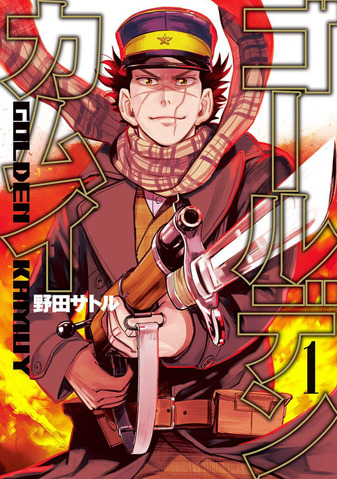
Just look at these covers!
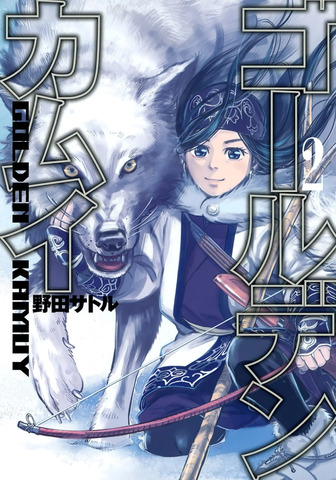
This coloring + color schemes!
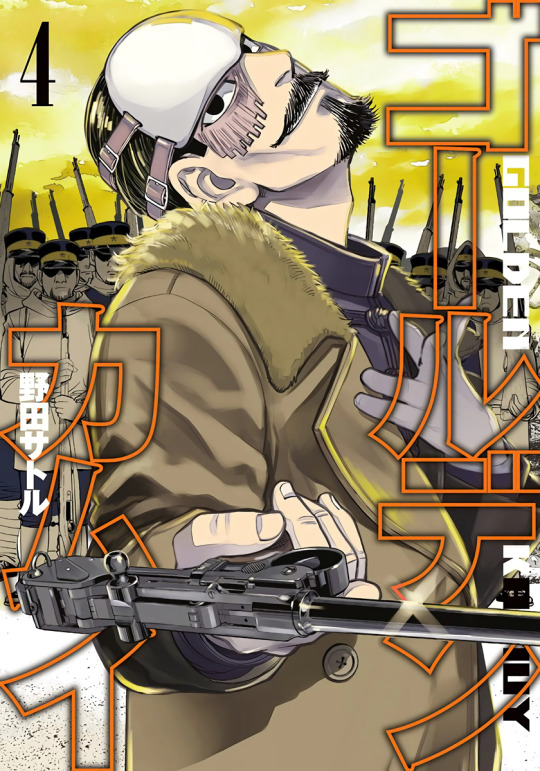
This character design!!
I’ve been raving about his character designs for a few paragraphs now but it’s just really that good. I love his eye for composition and his impeccable framing for action and comedy. I’ve always thought that framing comics need special planning – especially action + comedy ones. You have to ensure that the first thing the reader sees in the next panel will make the action/joke understandable and clear. It takes great skill to decide what the reader sees and doesn’t see. Through Golden Kamuy’s 158 chapters, he makes use of this skill to make us laugh whenever Asirpa’s badgering them to make citatap, or when there’s a new animal part to eat, or when Tanigaki’s out showing nudes of himself to people. If the pages weren’t framed well, the jokes would’ve fallen flat. Let’s also not forget his adeptness in drawing facial expressions. This manga just does faces so well.
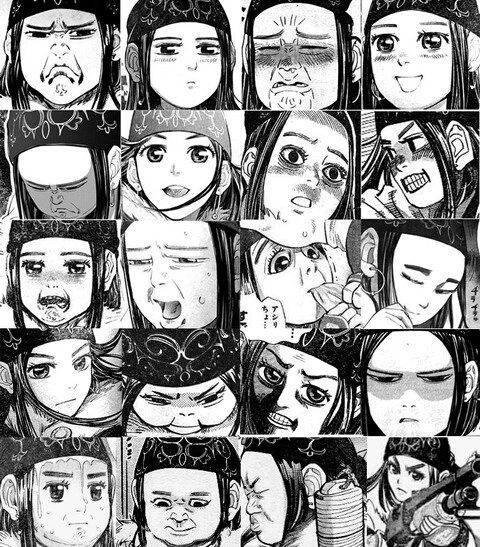
(Just look at Asirpa! collage c/o the Golden Kamuy reddit)
His fight scenes are also top-notch. You just know that Noda, as a mangaka, isn’t knocking about. The flow of action in every page is just downright superb. It also shows his mastery of human anatomy – and his courage when it comes to gore. His use of crisp blacks and whites, solid lineart, thick, expressive color give us pages that are fresh and clean...I’d be a fool to dismiss his technique, because his (and his studio’s, I guess?) skill just shines through every page.
He’s also not shy when it comes to details – which is admirable. After all, it takes some great dedication for someone to give his main character distinct facial scars that will require repeated drawings in almost every single page (and give his heroine a detailed headband). It makes me wonder just how he does it with a weekly schedule. His color pages look like they were done digitally, but I still have doubts whether or not he does his chapters by hand.
THE HEART
It took me just a few days to wolf down Kamuy. It was a romp right from the start – nail-biting, stomach-clutching, hair-raising. A truly entertaining piece, if you will. But if there’s one thing I’ve noticed with Kamuy, it’s that it somehow lacks heart.
Don’t get me wrong – it’s great! I love it. It’s superbly crafted, beautifully drawn, amazingly detailed. It’s one of the rare titles that I’m actually thinking of collecting. But it’s also a title that seems to drip technique. Like the author made it for the sake of drawing an intense, gripping title, but somehow solely for that purpose. It’s a career-conscious showcase of ability, a manufactured adventure in the truest sense. I couldn’t see the earnestness I found in Sorachi Hideaki’s Gintama, or the relatability of Nakahara Aya’s Dame na Watashi wo Koishite Kudasai. Full Metal Alchemist showed Arakawa Hiromu’s passion for muscled men, her interest in alchemy, and views on family, while Haruichi Furudate’s love for volleyball, sportsmanship and camaraderie is undeniable in Haikyuu!!. While I do like the backstory that Sugimoto is somehow based on his real-life war-vet grandfather, I find it a bit sad that it seems to lack that personal touch I’ve always liked seeing in other manga.
But it doesn’t mean that it’s not great. I will still recommend it to everyone I know. Awesome story, great art, refreshing comedy. By all means, read it! (Not sure about the anime, but I keep hearing reviews that we’re better off with the manga). Golden Kamuy is a title of both style and substance – whether it’s about the gore or the gold, I’m sure you won’t be disappointed.
Then let me know if you agree with my upcoming post, an analysis of Sugimoto and Asirpa.
Photos c/o reddit + our lovely scanlators + Satoru Noda
124 notes
·
View notes
Text
Get on the Beers with New Limited Edition Golden Kamuy Sapporo Cans

After being separated for years, best buds Sugimoto and Shiraishi will finally get to share a cold one on the latest Golden Kamuy designs for Sapporo Beer's "Classic" variety, while their frenemies — Hijikata, Ogata and Tsurumi — get to do the same.
/ お待たせしましたッ‼#ゴールデンカムイ缶 発売日決定‼ \ 今年は、人気キャラクターが大集合、 過去最高に豪華な2缶を発売します‼ 7月20日北海道限定発売ッ‼ ▶ https://t.co/pH1WjuFvN3#ゴールデンカムイ#サッポロビール#サッポロクラシック#クラシック pic.twitter.com/wuT44JtkAK
— サッポロビール SapporoBeer (@SapporoBeer) May 25, 2022
Both new can designs will be exclusively sold in Hokkaido from July 20 for a limited time.
RELATED: Golden Kamuy Celebrates Manga Conclusion with Giant "Snow Comic"
Sapporo Beer, which is featured in the Golden Kamuy anime, kicked off the collaboration in 2019 with individual Sugimoto and Shiraishi cans, before expanding to include Ushiyama in 2020 and Ogata in 2021.
皆さ〜ん!!ヾ(o´∀`o)ノ本日より #サッポロクラッシック ゴールデンカムイ缶の特設サイトにて、皆さんのTwitter投稿画像が一部公開ッ!! 「 #ゴールデンカムイ缶 」で投稿して一緒に #ゴールデンカムイ を盛り上げようッ!今年は白石も捕まえてねッ☆#サッポロビール → https://t.co/h5GtwcvQCM pic.twitter.com/RRVURe58if
— サッポロビール SapporoBeer (@SapporoBeer) July 24, 2019
/#ゴールデンカムイ缶 今年も発売! \ 今年は、人気キャラクター「 #牛山 」も加わった3種類のデザイン! 3缶並べると、キャラクター達が「 #乾杯ッ!」するオリジナルデザインを見逃すなッ! 7月21日北海道限定発売ッ! ▶ https://t.co/2Z2X84Nqe4#ゴールデンカムイ#サッポロビール pic.twitter.com/2vQDKUkuSt
— サッポロビール SapporoBeer (@SapporoBeer) May 27, 2020
_人人人人人人人人人人_ > 7月6日…発売ッッ!! <  ̄Y^Y^Y^Y^Y^Y^Y^Y^ ̄ みなさまからの投票で選ばれた #尾形 も #クラシック で祝杯! 発売まで、乞うご期待くださいッッ!! (※北海道限定発売) ▶https://t.co/Du9fn8fnh2#ゴールデンカムイ缶#ゴールデンカムイ pic.twitter.com/XsaCf2YhPe
— サッポロビール SapporoBeer (@SapporoBeer) June 23, 2021
RELATED: Golden Kamuy Season 4 Aims at Fall 2022 Broadcast in 1st Trailer
If you're a fan of historical action-comedy anime, check out the first three seasons of Golden Kamuy, right here on Crunchyroll!
The story takes place in the mighty Northern field of Hokkaido, the time is in the turbulent late Meiji Era. A post war soldier Sugimoto, aka, “Immortal Sugimoto” was in need of large sums of money for a particular purpose….
What awaited Sugimoto, who stepped into Hokkaido’s Gold Rush with dreams of making a fortune, was a tattoo map leading to a hidden treasure based on hints inscribed on the bodies of convicts in Abashiri Prison?! The magnificent nature of Hokkaido vs vicious convicts and the meeting with a pure Ainu girl, Ashiripa!! A survival battle for a hidden treasure hunt begins!
Source: Sapporo Beer official Twitter account

Der shy man behind @Shymander, Liam is a timezone-fluid Aussie with a distinct fondness for anime, Eurovision and creating odd stats projects despite hating math.
By: Liam Dempsey
0 notes
Text
Golden Kamuy Season 3 Release Date: Sequel Confirmed
The post Golden Kamuy Season 3 Release Date: Sequel Confirmed appeared first on Chikyuji Animes.
Golden Kamuy is one of the best, if not the best historical-seinen anime of 2018. The anime is massively popular and even after 2 seasons; fans are still clamoring for season 3. Now, Golden Kamuy season 3 has been confirmed to be in production! So, if you like Golden Kamuy and can’t get enough of the series, then you are in the right place. (Check: Kingdom Season 3.)
Today, I will tell you all you need to know about Golden Kamuy as a series and the much anticipated Golden Kamuy Season 3.
Now, before we get into Golden Kamuy’s Season 3, let’s take a look at what this series is all about.
Golden Kamuy is a historical-seinen genre anime series that portrays many real historical events with some twists. The series has been praised for its representation of a somewhat overlooked period in japan. It shows the historically known state of japan Hokkaido after RUSSO-JAP wars.

Golden Kamuy season 3 release date announced. Pic credit: Geno Studio
The author has been known to fact check important known events before portraying them in his manga, and that’s not the end of it. This series also portrays indigenous Ainu correctly in post-war Japan. This alone is no small feat, as the anime team itself had to travel to Hokkaido to work with the experts. They did this to make certain that they get all the details right.
This also tells us the care and length studio Geno was willing to go, in order to produce this anime as accurately as possible. This anime is also quite humorous. The jokes are sometimes unexpected and spot-on, while at other times they might just catch you by surprise.
Now, let us take a look at the plot of this historic anime to freshen our memories.
Golden Kamuy Plot:

Saichi Sugimoto Golden Kamuy season 2. Pic credit: Geno Studio
Golden Kamui follows an average guy by the name Sugimoto who survived the Russo-Japanese war of the Meiji era. He was nicknamed “Sugimoto the immortal” during the war.
But now our rumored immortal hero seeks the riches of the gold rush in Hokkaido to save the widowed wife of this best friend. During this journey, he stumbles across some information about a huge stash of gold hidden away by a criminal. Now, together with the girl who saved his life from the harsh North he ventures into an elaborate race against the criminals who also seek the same bounty.
Golden Kamuy Anime:

Golden Kamuy season 3 has been confirmed to be in production! Pic credit: Geno Studio
Golden Kamuy is one of those gems which stay true to the source material. The anime correctly adapts the manga from panel to panel which is very hard to find these days! And it seems to have done a very good job.
The voice acting is phenomenal and Combined with its stunning visuals and an amazing story. We get a very well-balanced show with good pacing that almost everyone can sit down and enjoy.
"Golden Kamuy" S3 anime announced https://t.co/IWL18inZtd pic.twitter.com/VeOolsLjd7
— A.I.R (Anime Intelligence (and) Research) (@AIR_News01) July 5, 2019
But there is a catch. Since we can’t always have nice things, Golden Kamuy’s anime has 3D effects. Now it’s not as bad as some other anime, but the 3D factor is still there. Now, let’s be a little fair to the anime, these scenes are very few and barely affect the overall enjoyment of the anime. Other than that, this anime is amazing with little to no flaws.
Golden Kamuy is a personal favorite of mine and its “comedic aspect” is just hilarious. Satoru Noda, the Author of Golden Kamui is known for his wackiness. This is reflected in his works as seen. And this anime will make you laugh without a doubt, and maybe cry later on. So, it’s a bouquet of emotions. Which is why this is a must-watch for any anime fan out there.
Golden Kamuy Manga:

Gōruden Kamui in Japanese. Pic credit: Twitter
Golden Kamuy’s Manga is huge in Japan. Now, this manga is a visual marvel. Each panel is heavy on details so much so that even the backgrounds are stunning, and it can be felt while reading this work of art that the editors have poured their hearts and souls into its production.
Golden Kamuy is so loved that it won the Manga Taisho award back in 2016. For those who aren’t aware Manga Taisho is a prestigious award in japan chosen by the booksellers themselves rather than the general reader to the manga’s, they find deserving. Having read the manga myself, I can say with certainty that it’s well deserved.
And even if you are not an avid manga reader; once you start it, the manga is so stunning that you will fall in love with it, and keep reading it all the while craving for more.
Golden Kamuy Season 3 Release Date:
Now, finally, after months of waiting and patience, Golden Kamuy Season 3 has been confirmed. This is not that surprising due to the series’ growing popularity over the past years. This news was released in July at the Golden Kamuy live event.
Happy New Year. Thank you for all the hard work. We are looking forward to Golden Kamuy season 3! https://t.co/K3eTBRqfGd
— Golden Kamuy Central (@KamuyCentral) December 30, 2019
Now we know that the anime is in production but no official date or even year has been released yet. But it’s certain that when it does, fans will swarm back to the anime like moths to a flame.
Golden Kamuy Season 3 Trailer:
youtube
The post Golden Kamuy Season 3 Release Date: Sequel Confirmed appeared first on Chikyuji Animes.
from Chikyuji Animes https://ift.tt/39QjSOC via IFTTT https://ift.tt/39QjSOC
0 notes
Photo

Golden Kamuy OAD Trailer
A dramatic new trailer has been published for the upcoming Golden Kamuy OAD, an original animation DVD that will be included as a pack-in bonus with the Japanese special edition release of Volume 19 of Satoru Noda’s raucous adventure manga about groups of rogue soldiers, criminals, and thieves all scrambling to find a stash of stolen golden in earlier 20th century Hokkaido.
he OAD adapts the events of Chapters 63 – 69 of Golden Kamuy (collected in Volume 7), in which Sugimoto and company are tasked with slaying a seemingly immortal red-furred bear that is terrorizing the ranch of an expatriate American horse breeder.
Golden Kamuy Volume 19 hits bookstores in Japan on September 19, 2019, and reservations for the limited edition with the bonus OAD are open until July 16, 2019. The special edition of Volume 19 retails for 3600 yen ($33.24 US) plus tax.
The original Golden Kamuy manga is serialized in Shueisha’s Weekly Young Jump seinen manga magazine, and an English language version is also available from Viz Media. The Golden Kamuy TV anime is directed by Hitoshi Nanba and Takahiro Kawakoshi and features animation production by Geno Studio.
The story takes place in the mighty Northern field of Hokkaido, the time is in the turbulent late Meiji Era. A post war soldier Sugimoto, aka, “Immortal Sugimoto” was in need of large sums of money for a particular purpose…. What awaited Sugimoto, who stepped into Hokkaido’s Gold Rush with dreams of making a fortune, was a tattoo map leading to a hidden treasure based on hints inscribed on the bodies of convicts in Abashiri Prison?! The magnificent nature of Hokkaido vs vicious convicts and the meeting with a pure Ainu girl, Asirpa!! A survival battle for a hidden treasure hunt begins!
#adventure#Geno Studio#Golden Kamuy#Hitoshi Nanba#Immortal Sugimoto#manga#Shueisha's Weekly Young Jump seinen manga magazine#Sugimoto#Takahiro Kawakoshi#Viz Media#Volume 19#Anime
0 notes
Text
Golden Kamuy Manga Ends in 3 More Chapters on April 28
It was announced tonight through Japanese media that Satoru Noda's Golden Kamuy manga will end in three chapters, the final of which will be released on April 28 in the combined Weekly Young Jump volume 22 and 23 issue. The series had reportable entered into its final arc in July 2021 and will finally conclude before the end of the month, ending the story of Saichi Sugimoto, the region of Hokkaido and its indigenous people, the Ainu.
It was further revealed that as of the release of volume 29 of the manga, which releases on April 19, Golden Kamuy has printed (physically) and sold (digitally) 19 million copies. In celebration of the final chapter release, all the previous chapters of the manga will be available for free digitally in Japan.
The Golden Kamuy manga has inspired three anime seasons so far with a fourth on the way in October 2022. The latest season aired between aired from October 5 to December 21, 2020, with all three seasons available to stream on Crunchyroll, which describes the series as such:
The story takes place in the mighty Northern field of Hokkaido, the time is in the turbulent late Meiji Era. A post war soldier Sugimoto, aka, “Immortal Sugimoto” was in need of large sums of money for a particular purpose…. What awaited Sugimoto, who stepped into Hokkaido’s Gold Rush with dreams of making a fortune, was a tattoo map leading to a hidden treasure based on hints inscribed on the bodies of convicts in Abashiri Prison?! The magnificent nature of Hokkaido vs vicious convicts and the meeting with a pure Ainu girl, Ashiripa!! A survival battle for a hidden treasure hunt begins!
Source: Mantan Web
-------
Daryl Harding is a Japan Correspondent for Crunchyroll News. He also runs a YouTube channel about Japan stuff called TheDoctorDazza, tweets at @DoctorDazza, and posts photos of his travels on Instagram.
By: Daryl Harding
0 notes
Text
Golden Kamuy Season 4 Aims at Fall 2022 Broadcast in 1st Trailer

The Winter 2022 anime season may be drawing to a close, but Golden Kamuy is keeping it cool with the first trailer for its upcoming fourth season, showing off all the high-pace action (and goofy comedy) to come in Fall 2022:
youtube
Brain’s Base (To Your Eternity) is taking over production from Geno Studio for the new season, with Shizutaka Sugahara (D-Frag) and Takumi Yamakawa (In/Spectre animation director) coming onboard as chief director and character designer, respectively, and Noboru Takagi returning for series composition.

If you're a fan of historical action-comedy anime, check out the first three seasons of Golden Kamuy, right here on Crunchyroll!
The story takes place in the mighty Northern field of Hokkaido, the time is in the turbulent late Meiji Era. A post war soldier Sugimoto, aka, “Immortal Sugimoto” was in need of large sums of money for a particular purpose….
What awaited Sugimoto, who stepped into Hokkaido’s Gold Rush with dreams of making a fortune, was a tattoo map leading to a hidden treasure based on hints inscribed on the bodies of convicts in Abashiri Prison?! The magnificent nature of Hokkaido vs vicious convicts and the meeting with a pure Ainu girl, Ashiripa!! A survival battle for a hidden treasure hunt begins!
Source: Golden Kamuy official website

Der shy man behind @Shymander, Liam is a timezone-fluid Aussie with a distinct fondness for anime, Eurovision and creating odd stats projects despite hating math.
By: Liam Dempsey
0 notes
Text
Golden Kamuy TV Anime Continues Its Journey Into Season 4 With Studio Change
Saichi Sugimoto's story through early Hokkaido continues with the announcement of the fourth season of the TV anime adaptation of Satoru Noda's manga series Golden Kamuy today at an event for the franchise. A teaser visual and trailer for the season were released alongside the news as well as the lead staff, which changes for the fourth season.
youtube
It was confirmed in the trailer that Shizutaka Sugahara (Grimms Notes the Animation) will take over as the chief director of the series at Brain's Base from Hitoshi Nanba at Geno Studio. Noboru Takagi continues to write the series composition for Golden Kamuy, while Takumi Yamakawa (animation director on 5 episodes of To Your Eternity) takes over as the character designer.
The latest season of the anime series aired between aired from October 5 to December 21, 2020, with Crunchyroll streaming all three seasons of Golden Kamuy, describing it as:
The story takes place in the mighty Northern field of Hokkaido, the time is in the turbulent late Meiji Era. A post war soldier Sugimoto, aka, “Immortal Sugimoto” was in need of large sums of money for a particular purpose…. What awaited Sugimoto, who stepped into Hokkaido’s Gold Rush with dreams of making a fortune, was a tattoo map leading to a hidden treasure based on hints inscribed on the bodies of convicts in Abashiri Prison?! The magnificent nature of Hokkaido vs vicious convicts and the meeting with a pure Ainu girl, Ashiripa!! A survival battle for a hidden treasure hunt begins!
Source: Golden Kamuy on Twitter
-------
Daryl Harding is a Japan Correspondent for Crunchyroll News. He also runs a YouTube channel about Japan stuff called TheDoctorDazza, tweets at @DoctorDazza, and posts photos of his travels on Instagram.
By: Daryl Harding
0 notes
Text
Talented Taxidermist Joins the Cast of Golden Kamuy TV Anime
A mother's boy who wouldn't hurt a fly is joining the cast of Golden Kamuy, because voice actor Yūma Uchida has been announced in the role of Yasaku Edogai. A taxidermist by trade, Edogai moved to Hokkaido because the cold climate was conducive to his trade, and due to his...peculiar...interests, he is recruited by Lt. Tsurumi in a conspiracy to forge fake tattooed skins.
youtube
The original Golden Kamuy manga is serialized in Shueisha's Weekly Young Jump seinen manga magazine, and an English language version is also available from Viz Media. The Golden Kamuy TV anime is directed by Hitoshi Nanba and features animation by Geno Studio. The first season of Golden Kamuy is currently streaming on Crunchyroll, who describe the story as follows:
The story takes place in the mighty Northern field of Hokkaido, the time is in the turbulent late Meiji Era. A post war soldier Sugimoto, aka, “Immortal Sugimoto” was in need of large sums of money for a particular purpose…. What awaited Sugimoto, who stepped into Hokkaido’s Gold Rush with dreams of making a fortune, was a tattoo map leading to a hidden treasure based on hints inscribed on the bodies of convicts in Abashiri Prison?! The magnificent nature of Hokkaido vs vicious convicts and the meeting with a pure Ainu girl, Asirpa!! A survival battle for a hidden treasure hunt begins!
Golden Kamuy returns to Japanese TV for a second season in October of 2018, and the series will also continue to stream on Crunchyroll.
Sources:
Ota-suke
Official Golden Kamuy TV anime home page and Twitter feed (@kamuy_anime)
---
Paul Chapman is the host of The Greatest Movie EVER! Podcast and GME! Anime Fun Time.
1 note
·
View note
Text
Golden Kamuy Season 3 Charges Forth with New Promo, Premiere Date, OP/ED Artists

The TV anime adaptation of Satoru Noda's Golden Kamuy anime is getting ready to return, and the official website went up with more details today. Golden Kamuy season three is set for an October 5 debut in Japan, with FOMARE on the opening theme, "Grey," and THE SIXTH LIE on the ending theme, "Yusetsu."
You can sample the OP along with more footage in the new promo below.
youtube
Golden Kamuy season three is scheduled to start airing from October 2020 on Tokyo MX. Crunchyroll streamed the first two seasons and described it as:
The story takes place in the mighty Northern field of Hokkaido, the time is in the turbulent late Meiji Era. A post war soldier Sugimoto, aka, “Immortal Sugimoto” was in need of large sums of money for a particular purpose…. What awaited Sugimoto, who stepped into Hokkaido’s Gold Rush with dreams of making a fortune, was a tattoo map leading to a hidden treasure based on hints inscribed on the bodies of convicts in Abashiri Prison?! The magnificent nature of Hokkaido vs vicious convicts and the meeting with a pure Ainu girl, Ashiripa!! A survival battle for a hidden treasure hunt begins!

Source: Official website via Comic Natalie

-------
Joseph Luster is the Games and Web editor at Otaku USA Magazine. You can read his webcomic, BIG DUMB FIGHTING IDIOTS at subhumanzoids. Follow him on Twitter @Moldilox.
0 notes
Text
FEATURE: A Handy Guide for Anime Sequels For the Fall 2020 Season
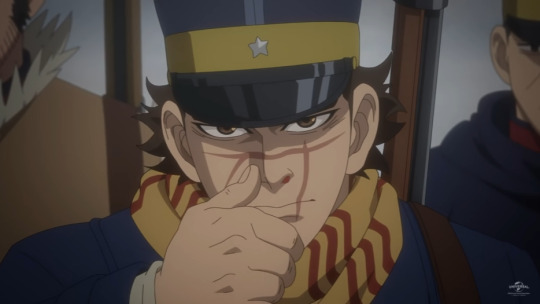
Image via NBCUniversal
Sometimes it can be difficult to keep track of what anime is broadcasting when, so Crunchyroll has compiled a helpful list of sequel series that will begin broadcasting and streaming during the Fall 2020 anime season. Below you'll find a list (in alphabetical order) of all the major productions that are coming back, the animation studios that are producing them, an official description of the show, and links to earlier seasons (if they are available on Crunchyroll) or info about where earlier entries can be found online.
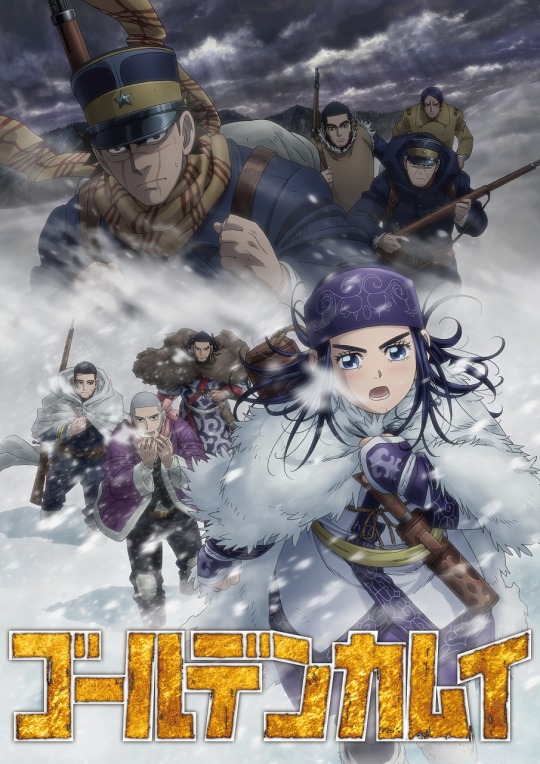
Golden Kamuy Season 3 (Geno Studio) - The story takes place in the mighty Northern field of Hokkaido, the time is in the turbulent late Meiji Era. A post-war soldier Sugimoto, aka, “Immortal Sugimoto” was in need of large sums of money for a particular purpose…. What awaited Sugimoto, who stepped into Hokkaido’s Gold Rush with dreams of making a fortune, was a tattoo map leading to a hidden treasure based on hints inscribed on the bodies of convicts in Abashiri Prison?! The magnificent nature of Hokkaido vs vicious convicts and the meeting with a pure Ainu girl, Ashiripa!! A survival battle for a hidden treasure hunt begins!
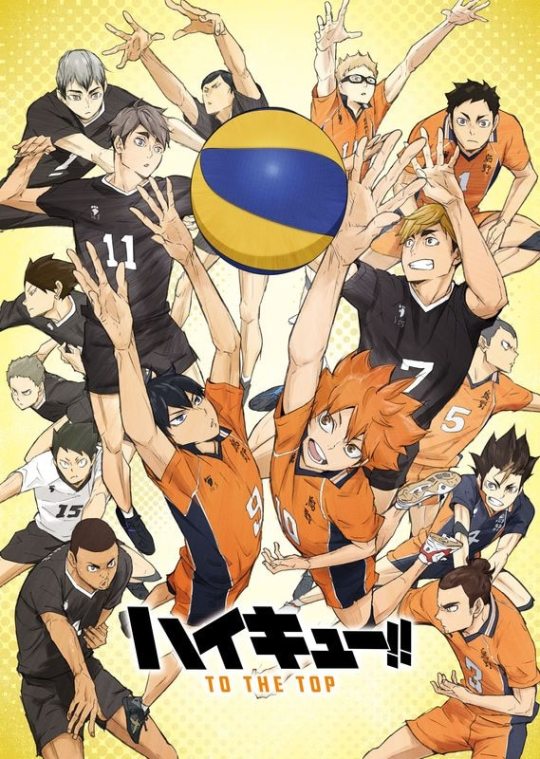
HAIKYU!! TO THE TOP Cour 2 (Production I.G) - Based off of the original Weekly Shonen Jump manga series from Haruichi Furudate, Haikyu!! is a slice-of-life sports anime revolving around Shoyo Hinata’s love of volleyball. Inspired by a small-statured pro volleyball player, Hinata creates a volleyball team in his last year of middle school. Unfortunately, the team is matched up against the "King of the Court" Tobio Kageyama’s team in their first tournament and inevitably lose. After the crushing defeat, Hinata vows to surpass Kageyama After entering high school, Hinata joins the volleyball team only to find that Tobio has also joined.
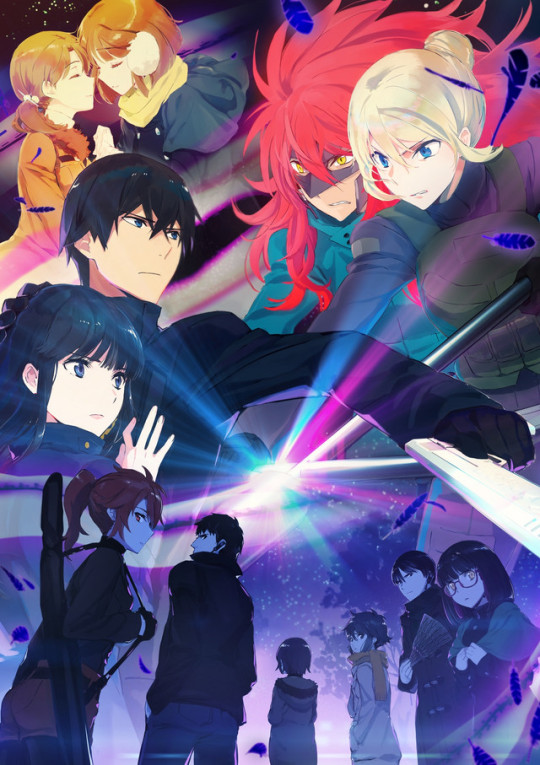
The Irregular at Magic High School Season 2 (Eight Bit) - Based on the light novel by Tsutomu Sato, the irregular at magic high school is set in a world where magic exists but instead of using chants and spells, magic users cast spells with their Casting Assistant Device (CAD). The CAD is infused with the user’s Psions (a substance-less thought particle) that activates the device and constructs the magic ritual.

Is It Wrong to Try to Pick Up Girls in a Dungeon? III (J.C. Staff) - Based off of a light novel of the same name written by Fujino Omori and illustrated by Suzuhito Yasuda, Is It Wrong to Try and Pick Up Girls in a Dungeon? is set in the world of Orario, where adventurers band together and look for treasures in an underground labyrinth known as Dungeon. However, for Bell Cranel, fame and riches are secondary to what he wants to find the most: girls. He soon finds out though, that anything can happen in Dungeon, and winds up being the damsel in distress instead!
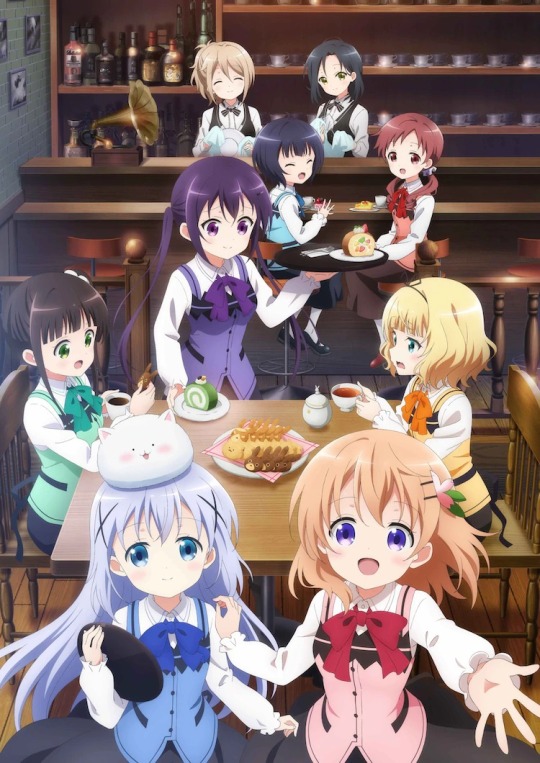
Is the Order a Rabbit? BLOOM Season 3 (Encourage Films) - Kokoa arrives in a new town in spring to start high school. She gets lost and pops into a coffee shop called "Rabbit House," which turns out to be where she will live. All the characters are so cute — tiny but cool Chino, soldierly Lize, gentle and Japanese Chiyo, sophisticated but down-to-earth Sharo. They are joined by Chino's classmates Maya and Megu, and a regular at the shop, Mr. Blue-Mountain Aoyama. Everything is so cute every day at Rabbit House!
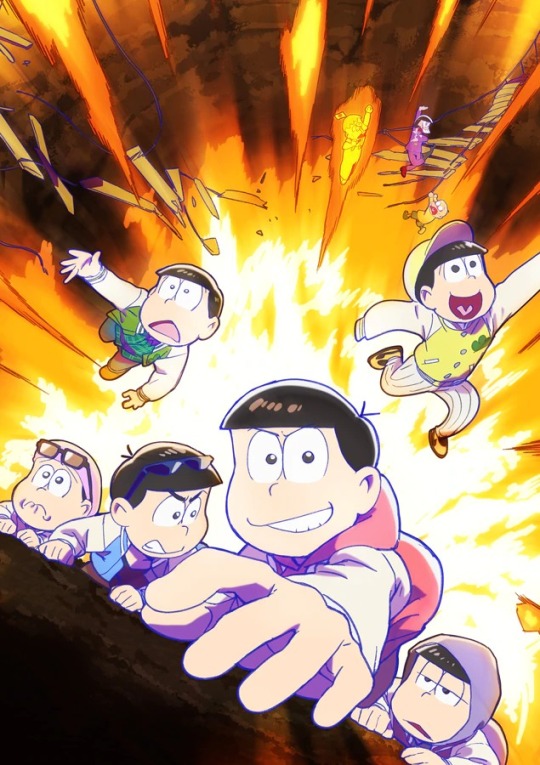
Mr. Osomatsu 3rd season (Pierrot) - Mr. Osomatsu is based off of the gag manga series Osomatsu-kun by Fujio Akatsuka and ran from 1962-1969. The series features a set of sextuplets, the Matsuno brothers, with Osomatsu being the oldest brother and leader of the group.

Seizei Ganbare! Mahou Shoujo Kurumi 3rd Season (Pie in the sky) - Kurumi Azuchi-Momoyama is an ordinary 14-year-old high school girl until one day a Tazmanian Devil-type Angel named Debirun recruits her to be a Beautiful Magical Girl Dinosaur Angel Warrior. Afterward, Kurumi dispatches the minions of the evil organization, Darkness Whales, with numerous blood-soaked weapons. All of this is witnessed by her bemused classmates, a trio of boys who are the protagonists of the show.
The previous two seasons can be viewed in raw Japanese via the official Seizei Ganbare! Mahou Shoujo Kurumi website.

501st Joint Fighter Wing Strike Witches ROAD to BERLIN (David Production) - In 1944, the world lives in fear of unidentified flying objects that even the military can’t thwart! Humanity turns its desperate eyes to the girls of the 501st Joint Fighter Wing, better known as the Strike Witches. These dolls blast aliens to bits in the bat of an eyelash, and with a little magic and a whole lot of leg, the girls of the 501st are winning the war on pants — and aliens!
Previous seasons of Strike Witches are available via Funimation.

TSUKIUTA. The Animation 2 (Children's Playground Entertainment) - Six Gravity and Procellarum are two rival male idol groups who happen to live in the same dorm. Six Gravity is made up of young men who represent the months of December to May, while Procellarum’s members represent June to November. Follow the daily lives of these twelve young men as they deal with the stresses of idol-hood, school, and living together. With music by famous Vocaloid producers!
The previous season of TSUKIUTA. The Animation is available via Funimation.
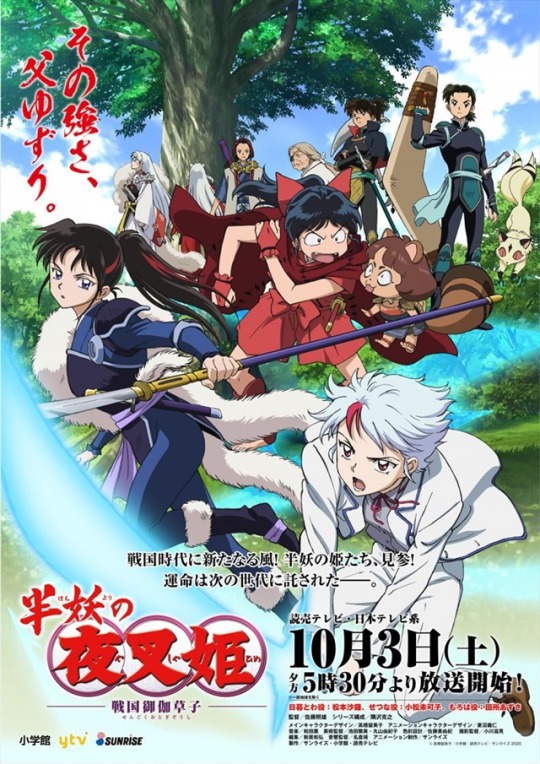
Yashahime: Princess Half-Demon (Sunrise) - In Yashahime: Princess Half-Demon, the daughters of Sesshomaru and Inuyasha set out on a journey transcending time. Set in feudal Japan, half-demon twins Towa and Setsuna are separated from each other during a forest fire. While desperately searching for her younger sister, Towa wanders into a mysterious tunnel that sends her into present-day Japan, where she is found and raised by Kagome Higurashi’s brother, Sota, and his family. Ten years later, the tunnel that connects the two eras has reopened, allowing Towa to be reunited with Setsuna, who is now a demon slayer working for Kohaku. But to Towa’s shock, Setsuna appears to have lost all memories of her older sister. Joined by Moroha, the daughter of Inuyasha and Kagome, the three young women travel between the two eras on an adventure to regain their missing past.
Yashahime: Princess Half-Demon has been licensed for streaming in the U.S. by Viz Media.
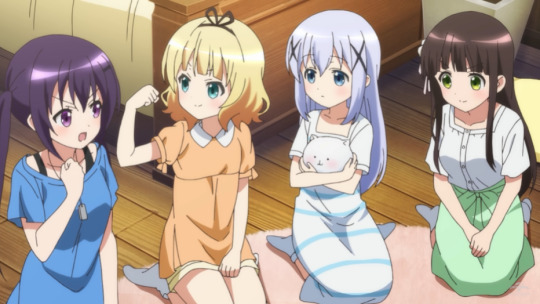
Image via NBCUniversal
Fall 2020 is jam packed with new entries for series that have wowwed the fans in seasons past, with genres that range from moe comedy to high fantasy to gritty action-adventure. What series are you most looking forward to returning to Japanese airwaves and the world of international online streaming? Be sure to let us know in the comments section below!

Paul Chapman is the host of The Greatest Movie EVER! Podcast and GME! Anime Fun Time.
Do you love writing? Do you love anime? If you have an idea for a features story, pitch it to Crunchyroll Features!
1 note
·
View note
Text
See the Sun Set in the 2nd Key Visual for Golden Kamuy Season 3 TV Anime
Hokkaido, Japan's chilly northern island, awaits in the third season of Golden Kamuy when the adaptation of Satoru Noda's manga series airs from October 5. In the lead-up, a new key visual was given the spotlight, with the sun setting on our favorite characters.
Previously released trailer:
youtube
Golden Kamuy season three is scheduled to start airing from October 5 on Tokyo MX. Crunchyroll streamed the first two seasons and described it as:
The story takes place in the mighty Northern field of Hokkaido, the time is in the turbulent late Meiji Era. A post war soldier Sugimoto, aka, “Immortal Sugimoto” was in need of large sums of money for a particular purpose…. What awaited Sugimoto, who stepped into Hokkaido’s Gold Rush with dreams of making a fortune, was a tattoo map leading to a hidden treasure based on hints inscribed on the bodies of convicts in Abashiri Prison?! The magnificent nature of Hokkaido vs vicious convicts and the meeting with a pure Ainu girl, Ashiripa!! A survival battle for a hidden treasure hunt begins!
Source: Comic Natalie
-------
Daryl Harding is a Japan Correspondent for Crunchyroll News. He also runs a YouTube channel about Japan stuff called TheDoctorDazza, tweets at @DoctorDazza, and posts photos of his travels on Instagram.
0 notes